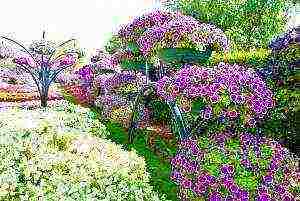Content
- 1 General characteristics of varieties
- 2 Early maturing varieties
- 3 Mid-season varieties
- 4 Late varieties
- 5 European varieties of melons
- 6 Central Asian varieties
- 7 Exotic melons
- 8 The sweetest melon varieties
- 9 Varieties for central Russia
- 10 Cantaloupe
- 11 Kassaba
- 12 Crenshaw
- 13 Torpedo
- 14 Galia
- 15 Collective farmer
- 16 Aikido
- 17 Cinderella
- 18 Golden
- 19 Ethiopian
- 20 Description and characteristics of common melon varieties
- 21 Description of sweet dessert
- 22 Early varieties
- 23 Mid-season varieties
- 24 Late varieties
- 25 Video "Planting melons in open ground and greenhouse"
Melon varieties: description, photo, reviews
All the varieties and hybrids of melons described here are included in the State Register and approved for cultivation on the territory of the Russian Federation.
Melon Torpedo, description and characteristics of the variety
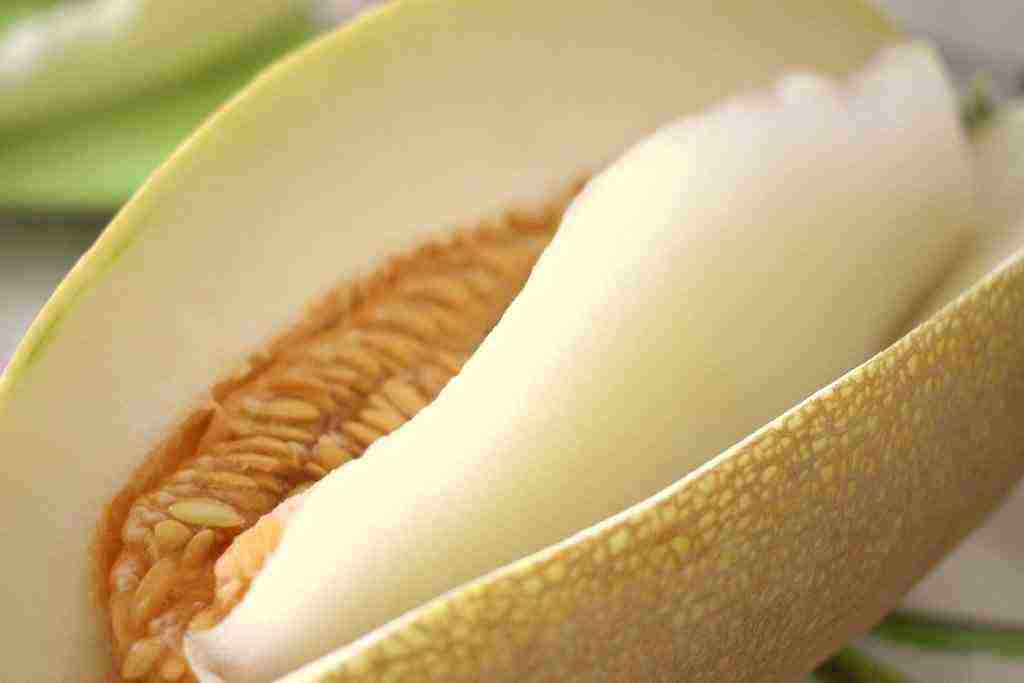
Mid-season variety. The plant is climbing. The leaf blade is medium-sized, green, dissected.
The fruit is elongated, gray, with a grayish tinge, smooth, mesh of medium thickness and medium density, mesh structure. The average weight of a torpedo melon is 2.5-6.0 kg. The pulp is greenish-white, of medium thickness, melting, tender, juicy, of excellent taste. The seed nest is medium in size. The seeds are long, of medium width, dark creamy yellow.
Yield: 1.8 kg / sq.m. The fruits retain their commercial qualities for 15-20 days after picking.
Melon variety Torpedo in 2017 is included in the State Register of the Russian Federation for cultivation in private household plots.
Originator of the variety: Agrofirm SEARCH.
Melon Kolkhoz Woman, variety description, photo
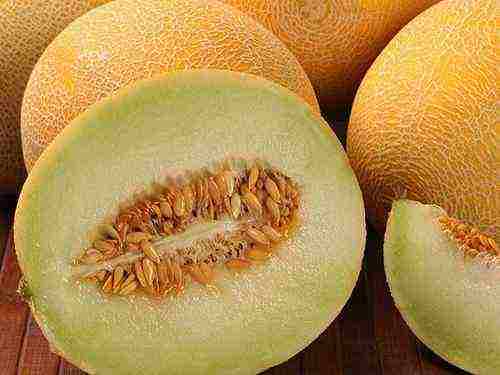
Mid-season, the period from full sprouting to the first harvest of fruits is 77-95 days. The plant is medium in size, long-leaved, the stem is thin, not coarse. The leaf is reniform, weakly globular, of medium size.
The fruit is spherical and medium-sized, weighing 0.7-1.3 kg. The surface of the fruit is smooth, yellow-orange in color, without a pattern. The mesh is sometimes found partial, coarse-meshed. The bark is of medium thickness, flexible and firm. The pulp is white, thin, fibrous, dense, semi-crispy, juicy, sweet. The seed nest is medium in size, the placenta is dry, walled, dense. The palatability of the fruit is good and excellent.
Marketable yield: 14.6-22.7 t / ha.
The variety is relatively resistant to bacteriosis; it is heavily affected by powdery mildew and anthracnose.
Variety value: good transportability of fruits.
Approved for use in the Central Black Earth, North Caucasian, Middle Volga, Lower Volga, Ural, West Siberian, East Siberian and Far Eastern regions in 1943.
Melon Ethiopka, variety description, photo
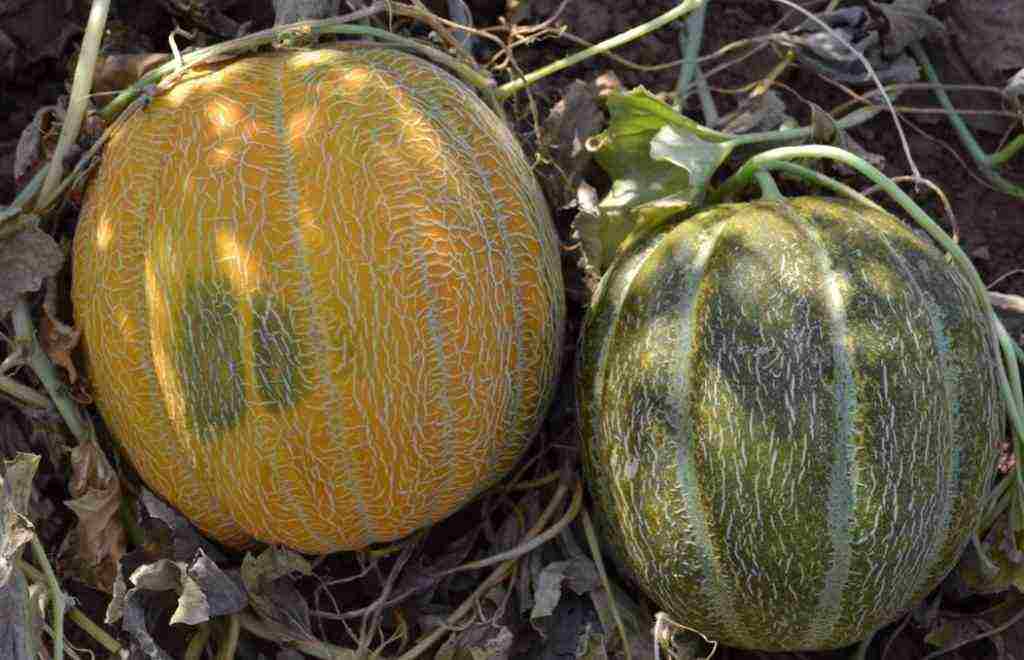
The variety is mid-season, the period from full sprouting to the first harvest is 80-91 days, 10-11 days later than the Zolotistaya standard. The plant is climbing. The leaf is medium-sized, green, slightly dissected.
The fruit is broadly round, dark yellow with an orange tinge, with a net of medium density and medium thickness, slightly segmented, smooth. Fruit weight 2.3-2.8 kg. The pulp is orange, melting, tender, juicy, of excellent taste, with a strong aroma. The seed nest is medium in size, the placenta is wall-mounted, dry, closed. Seeds are medium in size, creamy yellow.
Yield marketable fruits 89-145 c / ha, 43-49 c / ha higher than the standard. The fruits retain their commercial qualities for 14 days after picking. Flameproof.
In 2013, the Ethiopka melon variety was included in the State Register for the Lower Volga Region for growing on dry land in private household plots.
Originator of the variety: agrofirm Search.
Melon Delano, description and characteristics, photo
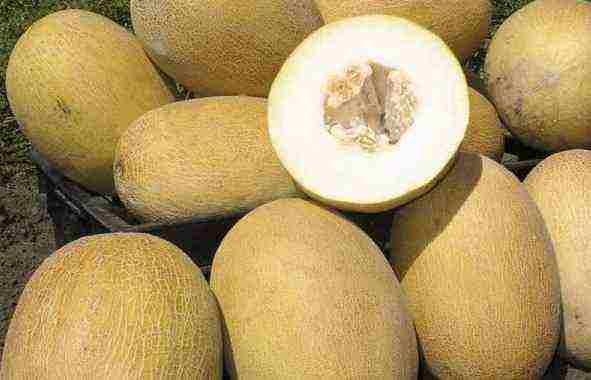
Mid-early, the period from full sprouting to the first harvest of fruits is 63-77 days. The plant is strongly plaited. The leaf is medium-sized, green, slightly dissected.
The fruit is oval, dark yellow, smooth, with a solid mesh of medium thickness. The average weight of the fetus is 1.5-2.3 kg. The pulp is light creamy, thick, tender, melting, juicy, of excellent taste, with a strong melon aroma. The dry matter content is 8.9-10.6%, the total sugar content is 5.7-8.8%. The seed nest is medium in size. Seeds are medium in size, narrow oval, pointed, light yellow. These melons are stable and transportable.
Yield marketable fruits on dry land 88-302 c / ha, 14-104 c / ha higher than Otrada and Tamanskaya standards.
The hybrid tolerates temperature extremes and is resistant to fusarium.
The Delano melon variety was included in the State Register for the North Caucasus region in 2009.
Originator: NUNHEMS (Holland)
Melon Amal, description, photo
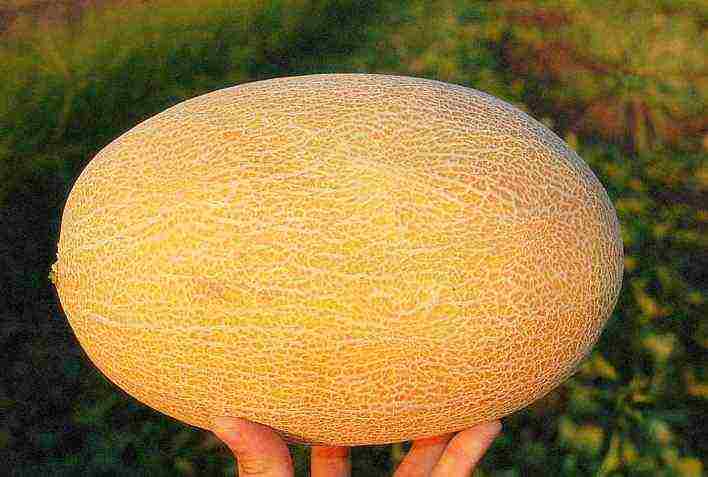
Mid-season melon hybrid. The plant is climbing. The leaf is medium-sized, green, strongly dissected.
The fruit is elliptical, ocher in color, with a pattern in the form of dots, smooth, with a fine continuous mesh of a linear structure. The average weight of the fetus is 1.4-2.6 kg. The pulp is dark creamy, thin, melting, tender, juicy, of excellent taste, with a strong aroma. The dry matter content is 8.4-11.0%, the total sugar content is 5.5-7.6%. The seed nest is small, the placenta is central, dry, closed. Seeds are medium in size, narrow oval, blunt-pointed, creamy yellow.
Yield marketable fruits on dry land are 93-140 c / ha, for Otrada and Tamanskaya standards - 108 and 88 c / ha.
Dignity: excellent transportability, resistance to fusarium.
Melon hybrid Amal F1 in 2009 was included in the State Register for the North Caucasus region.
Originator: CLAUSE (France).
Melon Lada

A mid-season melon variety, the period from full germination to removable ripeness (first harvest of fruits) is 74-96 days. The plant is climbing, the main lash is of medium length. The leaf is medium-sized, green, slightly dissected.
The fruit is round, yellow at the stage of maturity, without a pattern, smooth, with a solid mesh, weighing 1.5-2.0 kg, resistant to cracking. The pulp is of medium thickness, light creamy, crispy, tender, juicy, weak aroma. The taste is good and excellent. The dry matter content is 10.5%, the total sugar content is 8.4%. The seed nest is medium in size, cream. Seeds are oval, ivory. The mass of 1000 seeds is 39.6 g. The seed yield is 1.5%.
Marketable yield fruits under irrigation 211-218 c / ha, at the level of Yuzhanka standard.
Advantages of the variety: resistance to powdery mildew, tolerance to downy mildew and aphids.
Melon variety Lada in 2005 was included in the State Register for the Lower Volga region.
Originator of the variety: All-Russian Scientific Research Institute of Irrigated Vegetable and Melon Growing.
Melon Fairy Tale
An early ripening variety, the period from full germination to removable ripeness (first harvest of fruits) 60-62 days. Maturation is amicable. The plant is climbing. The leaf is medium-sized, green, slightly dissected.
The fruit is elliptical, yellow at the stage of maturity, without a pattern, slightly segmented, with a sparse mesh, weighing 1.6-1.8 kg (up to 2.3 kg). The pulp is light creamy, 2.5-3.0 cm thick, crispy, medium juiciness, sweet, with a weak aroma, good taste. Dry matter content 11.0-12.0%, total sugar 9.0-10.0%. The seed nest is medium in size, consisting of three dry, closed placentas. Seeds are narrow oval, ivory. The mass of 1000 seeds is 41 g. The seed yield is 1.0%.
Melon yield Fairy tale: 2.1-2.3 kg / m2, for the first two collections - 0.3-0.4 kg / m2.
This melon is recommended for local consumption as it is not suitable for long distance transport. The fruits retain their commercial qualities for 5-10 days after picking.
Dignity: resistance to powdery mildew, tolerance to downy mildew, early maturity, ripening amicability.
Melon variety Skazka in 2001 was included in the State Register of the Russian Federation for garden plots, home gardens and small farms for growing in open ground and under film shelters.
Originator of the variety: LLC Semko-Junior.
Altai melon
A good, time-tested early-ripening melon variety. The period from full germination to the first harvest of fruits is 65-75 days. Medium-sized plant, medium-growing. The leaf is pentagonal, weakly and strongly dissected, small. The petiole is short, oblique.
The fruit is oval and short-oval, of medium size, weighing 0.8-1.6 kg. The surface of the fruit is smooth or slightly segmented. In a ripe melon, it is lemon or orange-yellow in color, without a pattern, in an unripe melon it is green or dark green. The mesh varies from partial to complete, medium-mesh, delicate. The bark is soft. The pulp is light orange or white, thin, grainy, aromatic. The seed nest is large, the placenta is semi-liquid or liquid, filling less than half of the seed nest. The palatability of the fruit is satisfactory.
Flaws: low transportability and keeping quality of fruits.
Marketable yield: 25.0 t / ha (with proper cultivation techniques).
The Altai melon variety was approved for use in the Ural, West Siberian and East Siberian regions in 1955.
Originator of the variety: WESTERN SIBERIAN VEGETABLE EXPERIMENTAL STATION VNIIO.
Melon Caramel

A mid-early hybrid of a melon, the period from full germination to the first harvest of fruits is 62-66 days. The plant is strongly plaited. The leaf is medium-sized, green, slightly dissected.
The fruit is oval, dark yellow at the stage of maturity, smooth, with a continuous thick net. Fruit weight 1.2-1.9 kg. The pulp is light creamy, thick, tender, melting, juicy, of excellent taste with a strong aroma. The dry matter content is 8.5-9.8%, the total sugar content is 5.4-7.6%. The seed nest is small, the placenta is central, dry, closed. Seeds are medium in size, oval, blunt-pointed, creamy yellow.
Yield marketable fruits on dry land 94-156 c / ha, for the Otrada standard - 104-128 c / ha. The maximum yield is 260 c / ha, 172 c / ha higher than the Tamanskaya standard (Krasnodar Territory).
Hybrid advantages: transportable, tolerates waterlogged soil well, resistant to fusarium.
Melon hybrid Caramel F1 in 2009 was included in the State Register of the Russian Federation for the North Caucasus region.
Originator: CLAUSE (France).
Melon Aikido
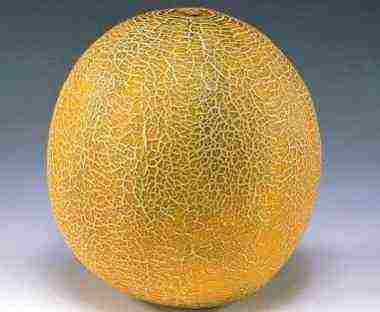
Mid-early - mid-season melon hybrid. The plant is climbing. Medium-sized leaf, dark green, dissected.
The fruit is round, yellow at the stage of maturity, segmented, with a net of medium density, weighing 1.4-2.1 kg. The pulp is light green, thick, melting, tender, juicy. The taste is good and excellent. Melon aroma. Seed nest of medium size, placenta - 3, their position is central. The seeds are creamy yellow, medium in size.
Yield marketable fruits on dry land 92-119 c / ha, at the level of the Otrada standard, for the first two harvests - 34-56 c / ha, at the standard level.
The hybrid is resistant to fusarium.
Melon Aikido F1 in 2006 was included in the State Register for the North Caucasus region for cultivation in private farms.
Originator: SAKATA.
Melon Raymond

Medium early hybrid, the period from full germination to the first harvest of fruits 65-75 days, 2-5 days later than the standard Golden. The plant is climbing. Medium to large leaf, light green to green, slightly dissected to dissected.
The fruit is elliptical, yellow with an ocher tinge, smooth, slightly wrinkled, with a dense, medium-thick mesh. Fruit weight 2.0-3.6 kg. The pulp is creamy, thin, crispy, tender, medium-bodied, good taste. The dry matter content is 9.2-9.3%, the total sugar content is 6.6-6.9%. The seed nest is medium in size, the placenta is central, semi-liquid, open. Seeds are blunt-pointed, creamy yellow.
Yield marketable fruits in the North Caucasian region when grown on dry land 108-284 c / ha, 7-213 c / ha higher than the standard, in the Lower Volga region when grown on dry land -112-128 c / ha, for the standard - 56-96 c / ha / ha, with irrigation - 214-346 c / ha, for the standard - 258-359 c / ha.
The hybrid is transportable. The fruits retain their commercial qualities for 30-40 days after picking.
Melon Raymond F1 in 2011 it was included in the State Register of the Russian Federation for the North Caucasus and Lower Volga regions.
Originator: HAZERA (Israel).
Melon Dune
An early ripe variety, the period from full sprouting to the first harvest of fruits is 58-75 days. The plant is climbing. The leaf is medium-sized, green, slightly dissected.
The fruit is oval, yellow at maturity, solid mesh, medium density.The average weight of the fetus is 1.4-1.7 kg. The pulp is light creamy, thick, grainy, dense, tender, juicy, of excellent taste. Melon aroma. Seeds are oval, blunt-pointed, medium-sized, ivory-colored. The mass of 1000 seeds is 41 g. The seed yield is 0.7%.
Yield marketable fruits on dry land 92-150 c / ha, 5-28 c / ha higher than the Autumn and Zolotistaya standards, with irrigation - 374-398 c / ha, at the level of 108 c / ha higher than the Zolotistaya standard.
The variety has good transportability.
Melon variety Dune in 2008 was included in the State Register for the Lower Volga region.
Originator of the variety: Bykovskaya Melon Breeding Experimental Station VNIIO.
Melon Cossack

A mid-season variety, the period from full sprouting to the first harvest of fruits is 70-95 days. The plant is long-leaved, medium-sized, with a thin stem. The leaf is reniform, strongly globular, of medium size.
The fruit is oval, medium-sized, weighing 1.2-1.8 kg. The surface of the fruit is smooth or slightly segmented, at the stage of maturity is bright yellow, without a pattern, sometimes mesh elements are found. The bark is hard, medium-strength. The pulp is white, of medium thickness, fibrous, slightly crunchy, dense, juicy, sweet. The severity is average. The seed nest is medium in size. The palatability of the fruit is good.
Yield: 17.7-28.7 t / ha.
The variety is moderately affected by powdery mildew and anthracnose.
Variety value: good transportability of fruits. Approved for use in the North Caucasian and Lower Volga regions in 1964.
Originator of the variety: JSC ‘ROSTOVSORTSEMOVOSCH’
Melon Cinderella
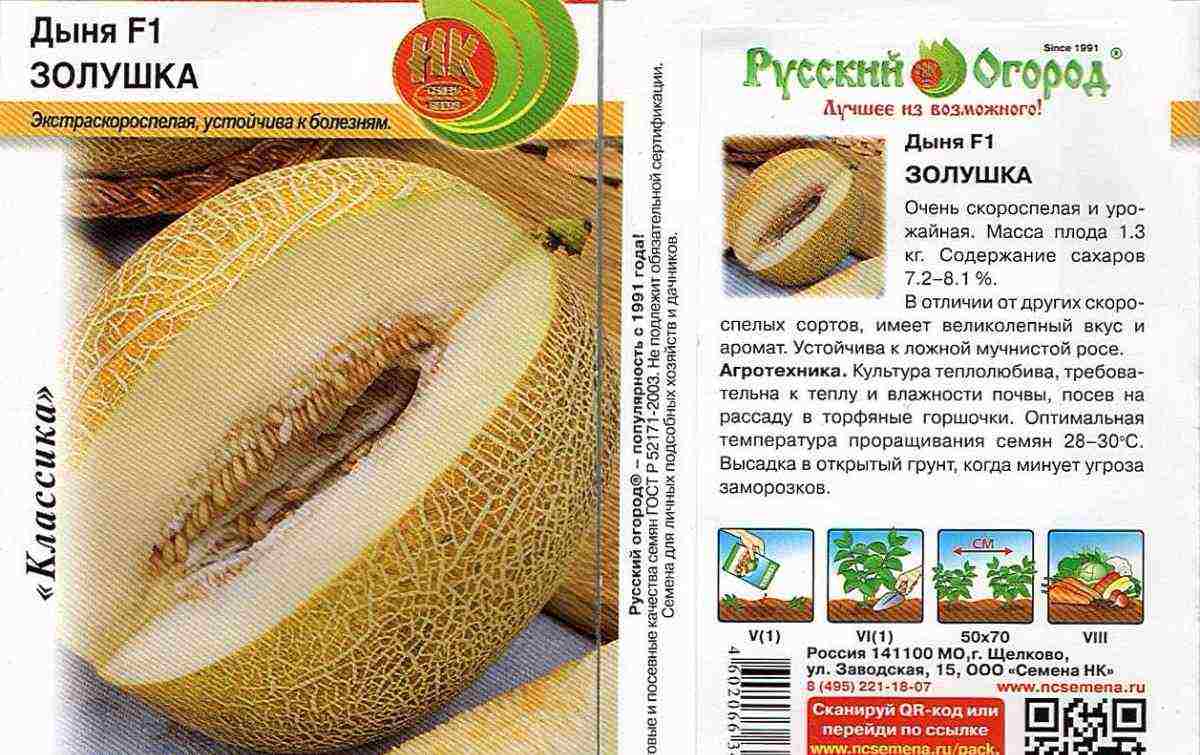
An early ripening variety, the period from full germination to removable ripeness (first harvest of fruits) 60-72 days. The plant is climbing. The leaf is medium-sized, green, slightly dissected.
The fruit is oval, yellow, without a pattern, smooth, with a solid mesh, weighing 1.1-2.2 kg. The pulp is light creamy, 3.0-3.5 cm thick, crispy, juicy, tender, of good taste. Dry matter content 7.0-11.4%, total sugar 5.4-9.3%. The seed nest is small, consisting of three central, dry, open placentas. Seeds are narrow oval, ivory. The mass of 1000 seeds is 46 g. The seed yield is 0.7%.
Marketable yield fruits 134 c / ha, for the first two harvests - 96 c / ha. The output of marketable products is 85%.
Melon Cinderella is recommended for local consumption. The fruits retain their commercial qualities for 15-20 days after picking.
The variety is resistant to low and high air temperatures.
In 2005, the Cinderella melon variety was included in the State Register of the Russian Federation for garden plots, home gardens and small farms.
Originator: BRANCH KUBAN OS VIR (KRASNODAR REGION).
Melon Tamanskaya
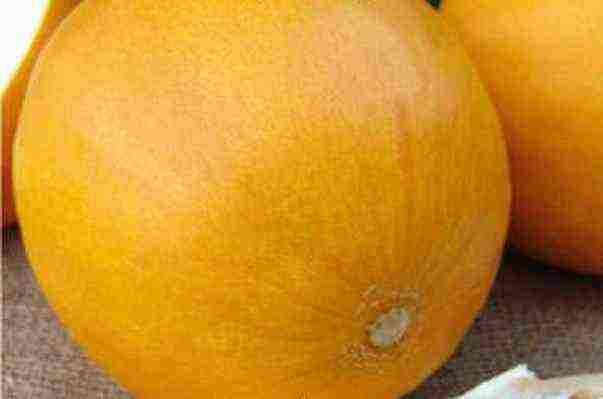
An early ripening variety, the period from full sprouting to removable ripeness (first harvest of fruits) is 53-80 days. The plant is climbing. The main lash is of medium length. The leaf is medium-sized, green, slightly dissected.
The fruit is oval, yellow in color, without a pattern, smooth, with a mesh of medium density. The seed nest is large, the position of the placentas is wall-mounted, the structure is open. The bark is thin, creamy on the cut. The pulp is creamy, of medium thickness, crumbly, grainy, tender, juicy. Fruit weight 0.5-1.3 kg. Good taste. The dry matter content is 8.1-12.5%, the total sugar content is 5.7-11.2%. Seeds are narrow oval, ivory. The mass of 1000 seeds is 28 g.
Yield marketable fruits on dry land 49-169 c / ha, for standards Zolotistaya and Otrada - 55-217 c / ha, for the first two harvests 34-104 c / ha, for standards - 37-78 c / ha.
The variety is transportable.
Melon variety Tamanskaya in 2004 was included in the State Register of the Russian Federation for the North Caucasus region.
Originator of the variety: VNII RISA (Krasnodar).
Melon Temryuchanka
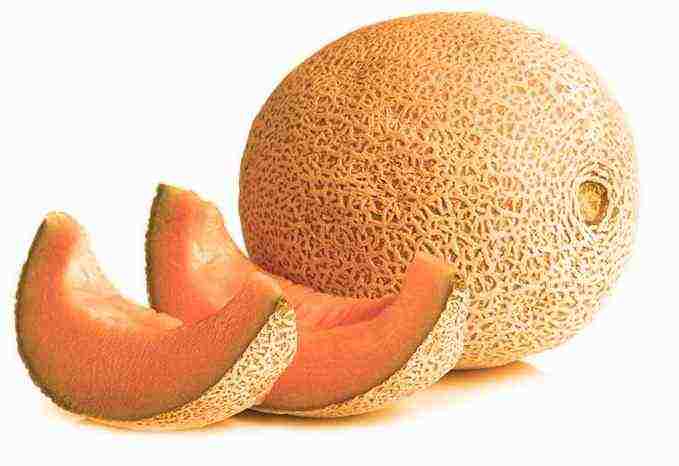
A mid-season variety, the period from full sprouting to the first harvest of fruits is 70-95 days. The plant is climbing. The leaf is medium-sized, green, slightly dissected.
The fruit is round, at the stage of maturity, dark yellow, without a pattern, slightly segmented, strongly wrinkled with a thick continuous mesh. Fruit weight 1.4-2.1 kg.The pulp is light creamy, thick, tender, melting, juicy, very sweet, excellent taste, with a melon aroma. The dry matter content is 8.3-11.1%, the total sugar content is 5.5-8.7%. The seed nest is small. The seeds are large, oval, blunt-pointed, ivory-colored. The mass of 1000 seeds is 35-40 g. The seed yield is 1.1%.
Yield marketable fruits on dry land 108-178 c / ha, 11-27 c / ha higher than the standards of Kazachka 244 and Zolotistaya. The maximum yield is 317 c / ha, 186 c / ha higher than the Zolotistaya standard (Krasnodar Territory).
The variety is transportable, resistant to stressful conditions. The fruits retain their commercial qualities for 25-30 days after picking.
The melon variety Temryuchanka in 2008 was included in the State Register of the Russian Federation for the North Caucasus and Ural regions.
Originator of the variety: VNII RISA, Tsybulevsky Nikolay Ivanovich (Krasnodar).
Melon Gold of the Scythians
Medium early hybrid of a melon, the period from full germination to removable ripeness (first harvest of fruits) 70-80 days. The plant is climbing. The leaf is medium in size, light green, slightly dissected, strongly toothed along the edge, slightly wavy.
The fruit is round in shape, when ripe it is yellow, with a thin dense net. The seed nest is medium in size. The position of the placentas is central. The pulp is creamy, 3.5 cm thick, melting, tender, juicy, sweet, aromatic. Fruit weight 1.1-1.3 kg. The taste is excellent. Seeds are narrow oval, ivory. The mass of 1000 seeds is 41 g.
Yield marketable fruits 6 kg / sq.m.
Hybrid value: high yield, excellent taste of fruits, resistance to powdery mildew.
In 2002, the Zlato Scythian F1 hybrid was included in the State Register of the Russian Federation for garden plots, home gardens and small farms for growing under film shelters.
Originator: LLC Selection firm Gavrish.
If you grow any other good melon varieties, please share your opinion in the comments. If possible, attach a photo of them. Your feedback on the varieties of melons will help many of our readers to learn more about them and decide which varieties and hybrids to plant on their site.
Melon has been a valuable and delicious plant since ancient times. Good varieties of melons are included in the golden fund of breeders all over the world, because these fruits are truly tasty, delicious, and, in addition to delicious taste, have healing properties. Candied fruits, marmalade, jam, sorbets, smoothies will sound different depending on the variety of these fruits.
General characteristics of varieties
Melon is considered a fruit by all, but strictly speaking, this vegetable is a direct relative of pumpkin. It belongs to the family of annual lianas, herbaceous plants called Cucurbitaceae in Latin. The homeland of the melon is the countries of Central Asia - Uzbekistan, Turkmenistan, Tajikistan, but agronomists managed to develop varieties and for Russia, cool for the fruit, there are worthy and fragrant types of melons. Let's talk about the most popular varieties of this culture.
Early maturing varieties
They are distinguished by a fast cycle from planting to harvest: everything takes a maximum of 70 days.
Two months is a record period for melons to ripen, and given that our summer is short, the period is optimal. Among the popular ones there are early varieties for open ground, and there are those that bloom and bear fruit on the windowsill.
The best varieties:
Melon Cinderella considered to be ultra-ripe. Its growing season is only 50 days. The fruits are mostly small - from 700 g, but sugar. The plant is resistant to diseases, it bears fruit well in temperate climates with capricious weather.
Melon Polydor. An early and very sweet hybrid variety with high yields. She ripens in about 65 days. The fruits are yellow-orange in color, weighing up to 2 kg. Plus Polydor in excellent transportability - melons do not wrinkle, do not crack.
White nutmeg. The cycle from planting to ripening is 2 months. During this time, fruits weighing from 600 g to 2 kg grow. The insides are juicy, but if you let it over-sing, it becomes cloying. The advantage of the variety is resistance to temperature changes.It is resistant even to frost and is readily grown in greenhouses by summer residents of the northern regions of Russia.
Melon Titovka. A super-early variety that matures in 65 days, but can be matured earlier in good weather conditions. Withstands frost, is not susceptible to disease, suitable for both greenhouses and open ground. Fruits are large up to 5.5 kg. Honey color with yellow-orange tints. They taste like sugar, moderately watery.
Star in the garden (another name is Silver Star). This interesting species, the result of the selection of Russian agronomists, matures in 63-68 days. Average weight of melons - up to 2 kg, spicy, delicate taste. Outwardly, the melons resemble large white eggs in green spots-stars. There are also disadvantages - the fruits love heat, and do not tolerate temperature changes.
Mid-season varieties
Such varieties are harvested at the end of summer: melons ripen for 70 -80 days.
Seeds are sown at the end of April when the soil warms up. The signal for planting in the ground is 4 real strong leaves in a peat pot with seedlings.
Varieties known to gardeners:
Collective farmer. One of the most popular varieties. Ripening time, 80-95 days. Melon weight - 0.7 -1.3 kg. With a shiny smooth skin, bright yellow or orange-golden color, most often it does not have a pattern. It is well transported, but not stored for a long time. Melon with creamy white, slightly crispy flesh. It is loved for its sweet honey taste and aroma. The variety is suitable for preservation - preserves, jams, candied fruits, but it is better to eat it fresh.
Early sweet. Despite the early name, the melon ripens in 70 days or a little longer. The fruits are large - up to 3 kg with a bright yellow smooth skin. The pulp is characterized by sweetness and rich melon flavor with a pineapple note. Advantage - resistance to anthracnose, powdery mildew. Also, the plant is unpretentious and can withstand frost. Experienced gardeners advise growing it in a greenhouse.
Don Quixote F1... A hybrid that bears fruit with the largest melons weighing up to 5 kg. The skin is moderately dense, green with a pronounced mesh. The pulp is sugar and white. A huge plus of the variety is that it is perfectly stored in its ability. They are stored in the cellar for 90 days without losing their taste.
Miracle Yudo. The fruits look funny: round balls with a dense patterned mesh. The crop is harvested 70 days after planting. Oval melons weighing up to 2.5 kg grow. The fruits are sweet, sugar, with density and juiciness reminiscent of a watermelon. Melon is not stored for a long time: it is important to eat it or process it into jams, candied fruits and preserves.
Blondie. Melon is recommended to start growing in April. It ripens by the end of summer, yielding a crop of small neat fruits weighing only 600 g. This is a bright striped melon: the stripes turn green against a snow-white background, which is why the variety got its name.
Amal F1. The most popular mid-season variety. From the first shoots to fruits, it takes about 80 days. The fruits are oval, covered with a net. The pulp has a pearly pink color, it melts in the mouth, spreading fragrant juices. Amal f1 is perfectly transportable and is suitable for marmalades and jams.
Late varieties
Despite the fact that it takes at least 90 days to wait for the collection of fruits, they are the tastiest and are perfectly stored.
Late varieties are the most popular among amateur gardeners. Plus, these varieties are resistant to pests and tolerate frost.
The best late melon varieties:
A pineapple. It grows and matures from 90 days from the moment of planting. The fruits weigh about 3 kg and are oval in shape. The peel is dense, the inside of the melon is orange, rich orange. The pulp has an oily taste, a pineapple-like aroma. Fruits can be transported without problems, stored for about 2 days, after which they can deteriorate.
Torpedo. One of the longest ripening varieties. From planting to harvesting, it can take at least 112 days. The torpedo tolerates droughts well, but does not like heavy rains. At the exit, excellent fruits weighing up to 8 kg are obtained. Torpedo is a sweet melon, and its aroma gets brighter the longer the melon is stored.For this property, the sellers of this sugar fruit love her.
Princess Mary. A well-known variety among Russian summer residents. Germination is excellent, disease resistance is high. She rarely gets sick, but always gives a rich harvest. The fruits of Princess Mary are not too large - up to 1.5 kg, and look like balls of gray-green color. The pulp inside is bright, orange, juicy with a nutmeg flavor.
Wintering. Best of all, it grows and bears fruit in the southern regions. The fruits grow medium in size - up to 3 kg, their shape is round, and the color is yellow-green. The flesh of the melon is not crunchy, rather creamy with a characteristic melon aroma. Moderately sweet.
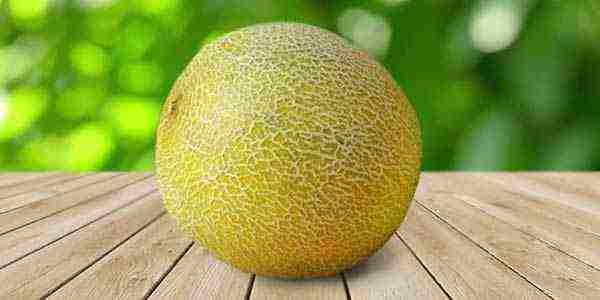
Golden. With some reservation, the variety can be called mid-season - the growing season is 90 days. Melons grow round, bright orange, without mesh and pattern. Melons weigh about 1000 g and are eaten "once": the pulp of the variety is juicy, with a bright aroma, slightly oily. The fruits are well stored and do not crack during transportation.
European varieties of melons
Foreign types of melons are not rare guests in Russian beds. Many of them take root well in our latitudes and give high yields.
Famous European varieties:
Charente. French melon variety. The fruits are mid-ripening, ripening in 70 days in the middle. The variety is distinguished by purely French grace: the shape of the fruit is small, neat, weight up to 1.5 kg, the surface is smooth. The taste is rich, and they are also fragrant.
Cantaloupe. Now it is very popular in Europe, America, and serves as a "muse" for breeders who create unpretentious fruitful varieties on its basis. Its shape is oval, the skin is dense and covered with a mesh. Cantaloupe is an orange melon inside, aromatic, with a pronounced honey flavor. It is curious that just such a variety is often found on the fruit "ruins" of Thailand and other Asian countries.
Melon Bolo. A widespread variety in Europe, which is distinguished by juicy strong pulp, fresh aroma (reminiscent of watermelon), sweet, but not cloying note. Even in appearance, it resembles an elongated watermelon.
In Europe, melon is eaten in rather unusual combinations for Russians: they love to add it to salads, cut into pieces for steaks, and eat it with cheeses. They also like to wash it down with wines, of which Europe is produced in abundance.
Central Asian varieties
The sweetest melon varieties grow in Central Asia.
In the steppes, under the burning Asian sun, they gain a special sweetness and juices. The taste and aroma of the fruit cannot be confused with anything. But what they like to cultivate in these parts - you will find out about this below.
The best Asian varieties:
Gulyabi (Charjui) melon. Even in the famous "Station for Two" the hero traded these melons in the market. It is called the "queen of melons" for its incredible taste. The fruits of the walk are elongated, resembling ostrich eggs. They are covered with a dense mesh, and can be yellow, whitish or greenish. The pulp is dense, aromatic. As soon as you bite a slice, you want to rumble with joy - so tasty it is. It is noteworthy that it does not gain taste immediately, but several days after collection. She perfectly tolerates transportation, which is why she is taken to Russia, and we can feast on her.
Kassaba. This is a late-ripening variety that finally ripens not in the fields, but after the harvest. Moreover, the sweetness comes to the melon only after 2-3 months of storage, and the freshly picked fruits are more reminiscent of cucumbers or zucchini in taste. The fruits are not large, weigh up to 2 kg. Melons often grow with a wrinkled, even warty surface, the color can be yellow or green. The peel is dense, thanks to which the fruits are perfectly stored.
Khandalyak (other names are Hondolyak Yellow, Orange, Kokcha, Kolagurk, Zami). You can try this early ripe variety only in Uzbekistan or Turkmenistan: it is poorly stored. This delicious fruit with a loose, soft, fragrant white pulp, weighing a little less than 2 kg, has the shape of a ball, which seems to have been flattened from the sides. The variety is not too sweet, but juicy - cool fruits perfectly save from the heat in Central Asia, for which the variety is highly valued there.
In Central Asia, melons also do not ripen immediately - the process takes from 130 to 140 days. But the heat has been there practically since March, so in the middle of summer they harvest there, eat it themselves and send it for sale to the regions of Russia.
Exotic melons
Some varieties are so unusual that they do not look like melons at all. But the characteristic aroma, taste still give out in them representatives of their culture.
The most famous varieties of melons:
Pineapple, Vietnamese. Tiny brown melon weighing up to 300 g. It is painted in bright light orange stripes, which alternate with chocolate ones. Melon tastes like pineapple - with a characteristic sourness. The flesh of the melon is soft, tender, slightly creamy.
Melotria. Rough (called the mouse) melon is native to North America. The variety is one of the smallest in the world - the fruits reach a length of 4 cm, no more. The melon grows just like a cucumber, the taste is also cucumber. In America, Milotria is often grown on windowsills - the plant is perennial and thrives in small pots. The melon taste is refreshing, not sweet at all. Melon is often fermented, pickled, added to salads.
Kiwano. An African variety that has recently come to Europe and is very popular there. The herbaceous liana gives small fruits - up to 15 cm, and is called horned: the surface of the fruits is decorated with conical thorns. Kiwano pulp is not eaten, but they are happy to feast on its core - green, refreshing, reminiscent of jelly in consistency. Melon is not stored for a long time, due to its delicate structure, but jams, jams and even salted are made from it.
It is clear that it will not be possible to grow such fruits in Russia, but it is imperative to try them on a trip.
The sweetest melon varieties
In addition to the above varieties, there are those that are only gaining popularity among consumers and gardeners around the world. Some feel great not only in the tropics, but also in our beds.
Popular are the following:
Banana melon. It is a type of cantaloupe that grows to about 90 cm in length. Its aroma and taste are reminiscent of bananas, and the melon looks like this tropical fruit. Banana melon began to appear in Russian summer cottages, where it is often grown alongside carrots, potatoes and beets.
Canaria. This is a hybrid bred by Russian agronomists. This is an ultra-early variety: in good weather, the melons are harvested within 2 months after planting. The melon has a dense, sweet filling. Canaria bushes resemble cucumber: vines grow long, with a strong root system.
Princess Anne. Sweet, honey hybrid. 2.5 months after planting seedlings in open ground, strong oval fruits weighing 1.5 kg appear. The variety is great for drying, turning into transparent candied fruit slices.
Varieties for central Russia
Lazy dream (another name is the Dream of Sybarite). This is a relatively new variety, bred by Russian breeders. Gardeners note that the variety ripens in just 55 days. The fruits are small, slightly elongated. Weight is about 500 g, and the pulp has a pleasant taste, with a bright honey flavor. The "lazy dream" is resistant to diseases, and it is also easy to grow it indoors: it pleases the eye with emerald greens, delicate leaves, and even bears fruit with small melons - with a tennis ball.
Bargi. This is an early Central Asian variety that takes root in our beds. It takes about 120 days before harvesting, after which summer residents collect oval, elongated-ovoid melons with a smooth orange-yellow skin, of medium size. The melon has an unusual taste, slightly reminiscent of a pear and gives off vanilla. The pulp is white.
Piel Sapo. This is a late variety - the harvest is harvested in early September. The fruits weigh about 2 kg each. Melons are dense, oval, slightly ribbed. The pulp is crispy, firm and fresh.
Dear summer residents and gardeners, no matter what variety you choose, any culture requires attention and care. Fruits and leaves infect wireworms, attack spider mites, powdery mildew and fusarium.In order for the culture to give a good harvest, watch the melons carefully, feed them and do not overuse watering. Then in the fall or already in the summer you will enjoy amazingly juicy fragrant fruits!
Cantaloupe

Culinary experts use cantaloupe in their dishes, as it has a strong aroma and pleasant taste.
Melons of this variety stand out from many others with their thick rind. It is dotted with networks of stripes that look like cracks. Cantaloupe fruits are oval or round, most often of medium size (they reach about 20 cm in length). The melon is very sweet and juicy, its flesh is yellow, close to orange.
Another name for the variety is cantaloupe. It is actively grown in Europe, where it came from Armenia in the 15th century. At one time it was a gift from Armenians to the Pope of Rome. I liked the present, and the head of the Catholic Church ordered to start growing such melons on his estate in Cantalupia (hence the name for the variety). Cantaloupe ripens a little earlier than its counterparts - around the beginning of August. It is well transported and stored.
Melons have a limited shelf life - they can only be eaten within 3 weeks after harvest. Further, the fruits begin to lose their taste.
Kassaba
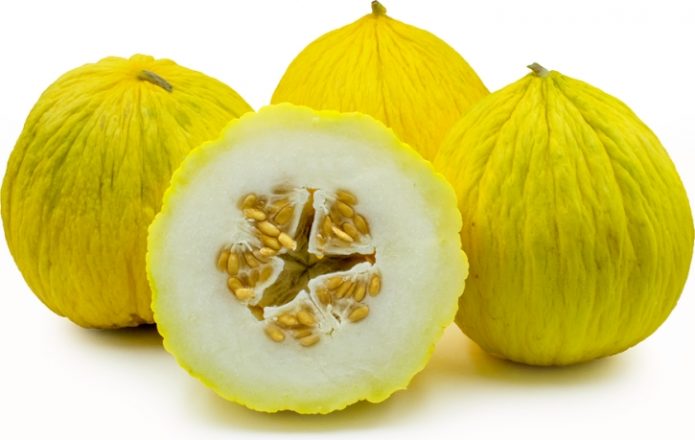
The flesh of the cassaba in the cut is dense, in freshly cut fruits it is grassy with a cucumber aroma
Cassaba (or winter melon) differs from other varieties of melons in almost complete absence of a strong smell. By the time of its ripening, the fruit has a round, slightly flattened shape. He has a bright yellow or creamy rind with small dark green specks and white flesh. Usually kassaba ripens in the soil in the middle of autumn. This is one of the latest varieties that can be found in large stores from mid-September to almost December.
During the storage period, the cassaba acquires an even richer taste, which compares favorably with the fruits of the same variety, which have just been removed from the garden. That is why it is called "winter", that is, reaching the maximum of its taste closer to winter.
The variety is used for cooking Indian and Asian dishes. It is also good for health: experts on proper nutrition distinguish winter melon from all other varieties, as it does not contain cholesterol.
Crenshaw
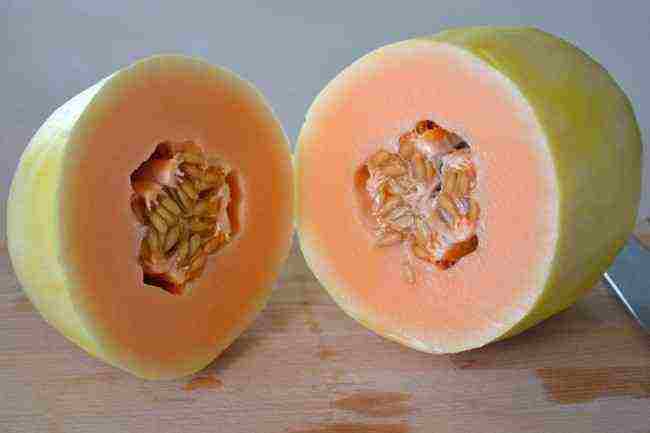
Crencho melon is often added to salads and made into juices.
Melon with yellow peel and orange flesh is a hybrid obtained by combining cassab and Persian varieties. Crencho has a unique and incomparable juicy taste, as well as a sweet-spicy aroma. The size of the roll can grow up to 4 kg. It ripens in mid-August - early September.
Another distinctive feature of the variety is its oval shape.
Melon is one of the best foods for people with dry skin, as it contains a lot of vitamin C to help moisturize it.
Torpedo
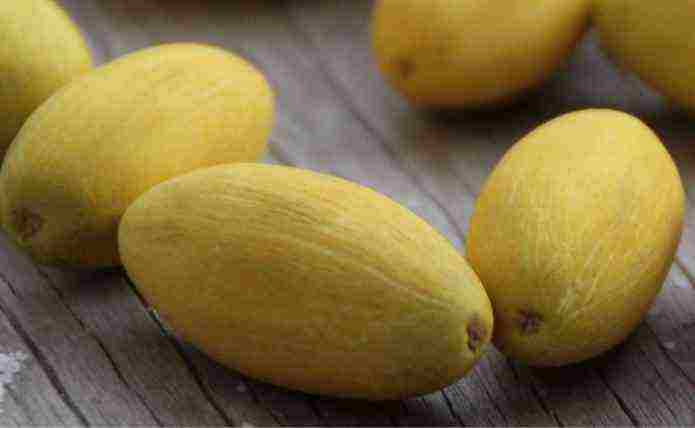
Fresh use of a torpedo can stabilize intestinal function and enhance the properties of the immune system.
A variety that is well known to Russians. The elongated yellow fruit has a rough mesh structure. The color of the honey pulp is white and even milky. Torpedoes ripen at the end of summer, they mainly grow in Central Asia. The variety tolerates transportation well, and that is why these melons can be found so often at Russian fruit fairs.
Torpedo is considered a late variety, so melons, which sometimes appear in supermarkets until the end of August, should be treated with caution: most likely, stimulants were used to grow them.
For the first time, such melons began to be grown in Uzbekistan. There are all conditions for torpedo growth - hot and dry climate. The variety got its name due to its oblong shape. The torpedo is considered a dietary product, it is actively used in cooking (and even crusts are used).
Galia
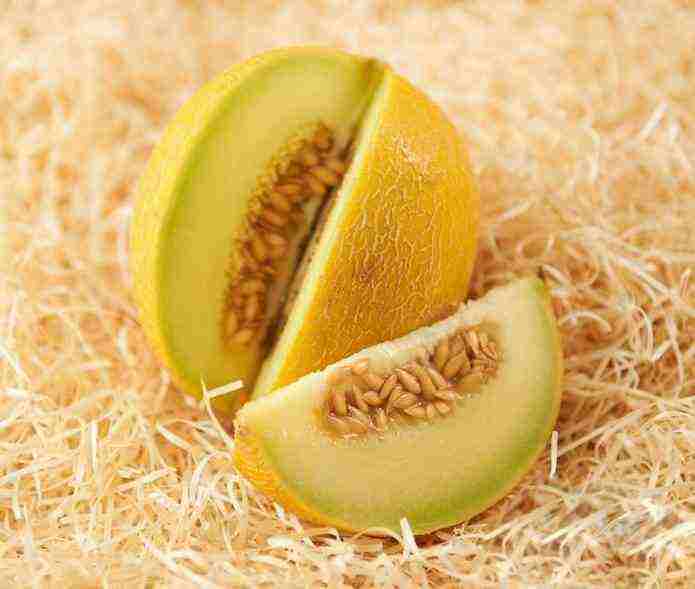
Galia is ideal for making candied fruits
Galia is a melon that produces the most impressive fruits in size. And this is its distinguishing feature.Such melons have a round shape, their rind is yellow, with a slight orange tint and a network of small cracks. Inside there is a dark, greenish pulp with a sweet taste and bright aroma. Galia is a variety of Israeli origin. Now it is actively grown in South America, Chile and some states of the United States.
The variety is considered very unpretentious. It ripens within two months and appears on the shelves in early August. In terms of sugar content, the fruits are similar to the cantaloupe variety.
Galia is often used in a variety of dishes, from salads to desserts.
Collective farmer

The collective farmer can be grown both in a greenhouse and in a greenhouse
Another variety that is often found on our counters. In the Soviet Union, the collective farmer began to actively grow from the pre-war 1939. The variety was officially included in the State Register of Breeding Achievements of the state and was cultivated in the Astrakhan region, the North Caucasus, Siberia and even the Far East.
It is easy to recognize a collective farmer: she is spherical, very compact in size and with a smooth orange-yellow crust. The variety matures quickly enough and is not afraid of weather surprises. But despite the fact that the melon tolerates transportation well and is not afraid of the cold, the delicious and sugary fruit is not subject to long-term storage.
Aikido
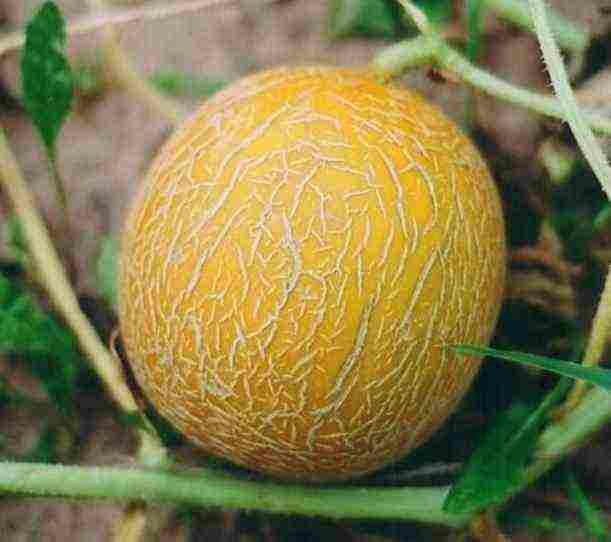
Aikido is a high-yielding variety that is resistant to many diseases
A hybrid variety adapted for central Russia. Aikido feels good in a greenhouse or in a film-coated garden bed. It takes about 70 days to ripen. It is important not to miss the moment when the fruits of this variety are ready for consumption, because they overripe quite quickly. The variety reaches a size of 2 kg. The shape of the melon is round, the rind is orange, covered with small stripes. The variety is very pleasant to the taste. It is juicy, tender and literally melting in your mouth.
Cinderella
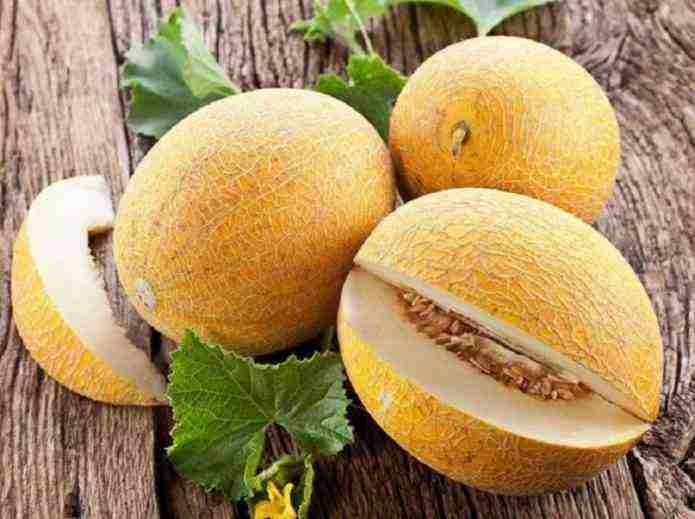
Cinderella is not stored for long, it is poorly transported due to the fact that the crust of melons is rather thin and stiff
From the emergence of the first shoots from the ground until the melon can be washed, cut and served, it takes about two months. Cinderella is often grown in central Russia, where summer is fleeting. Already in early August, melons of this variety appear on the shelves of fruit shops in many Russian cities. Ultra-ripening fruits have time to ripen even in bad weather. It grows well both in greenhouses and in open ground.
The fruits of such melons are oval, with an even yellow color and without any pattern. The melon usually grows to 1.5 or 2 kg. The crust of the fruit is thin, and the light creamy flesh is very juicy and crunchy.
Cinderella contains about 9% sugars, however, due to its rich aroma, this variety belongs to a highly valuable culinary culture.
Golden
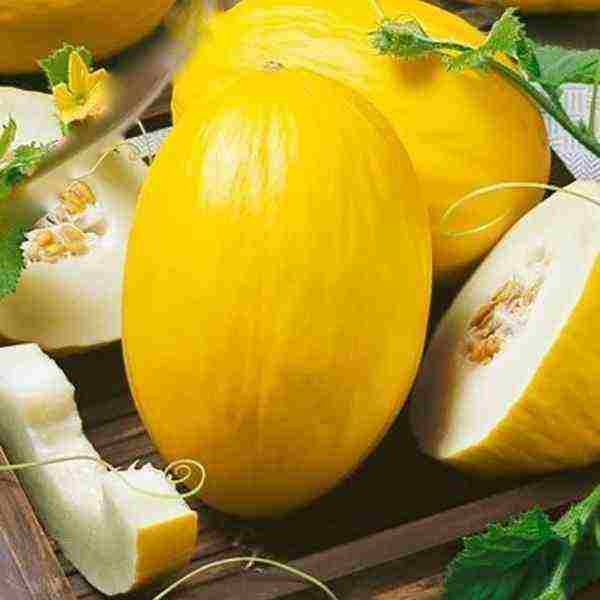
Golden melon gives a good and stable harvest.
The homeland of golden melon is the Krasnodar Territory. It ripens in 70 days. Grows outdoors or in a greenhouse. Already in mid-August, it can be found in stores. The fruits of the variety are easily recognizable by their round and slightly elongated shape. The network of cracks on the orange-yellow surface of the melon is poorly expressed, but it is there. A very tasty pulp is hidden under the peel. It tastes juicy and tender.
The structure of the pulp of the variety is not watery, but rather dense, which is liked by many buyers. Thanks to this quality of the product, the melon is easy to transport and store. By weight, golden grows up to 1.5 or 2 kg.
Ethiopian
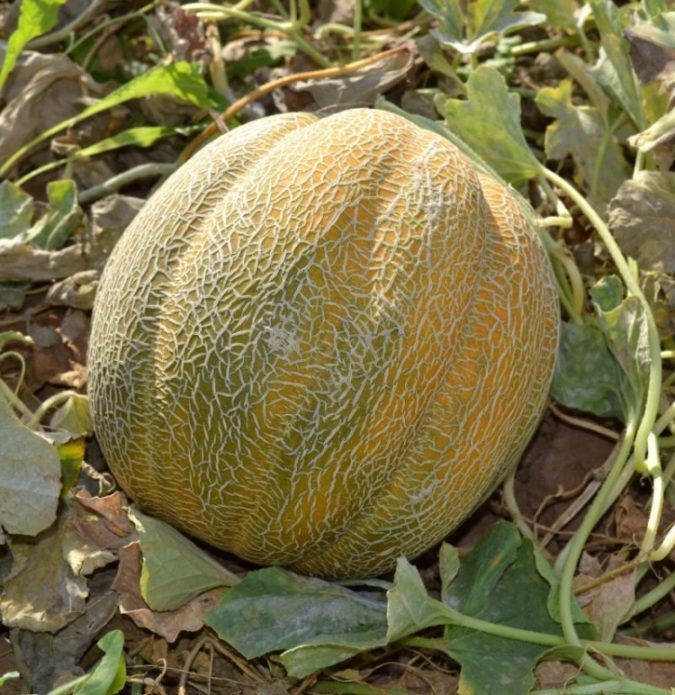
Ethiopian is mainly consumed fresh
Bred by Russian breeders relatively recently. The variety is classified as mid-season. The ripening period of the melon can stretch over the whole summer. They usually try it already in September. Outwardly, the Ethiopian looks more like a pumpkin than a melon. The fruits of the variety are very large. They can weigh up to 3.5 kg, which is more than many other popular varieties. Fruit rind is dark yellow, with green stripes and a branched network of small cracks. Hidden inside is orange pulp, which has a very strong aroma carrying honey tints.
The variety is thermophilic (as you can guess by its name), therefore it is grown exclusively in the southern regions.
Melons surprise with their variety. They differ in shape, color, pulp structure and taste. But in one thing they are exactly similar - in the beneficial properties that characterize the melon culture. All melons are rich in proteins, carbohydrates and mineral salts that improve physical fitness, help the body gain strength and prepare for winter. In late summer and early autumn, the melon should appear on the table as often as possible. And it is desirable that every time it was some kind of completely new variety.
Rate the article:
(6 votes, average: 5 out of 5)
Melon varieties: description, photo, reviews
All the varieties and hybrids of melons described here are included in the State Register and approved for cultivation on the territory of the Russian Federation.
Melon Torpedo, description and characteristics of the variety

Mid-season variety. The plant is climbing. The leaf blade is medium-sized, green, dissected.
The fruit is elongated, gray, with a grayish tinge, smooth, mesh of medium thickness and medium density, mesh structure. The average weight of a torpedo melon is 2.5-6.0 kg. The pulp is greenish-white, of medium thickness, melting, tender, juicy, of excellent taste. The seed nest is medium in size. The seeds are long, of medium width, dark creamy yellow.
Yield: 1.8 kg / sq.m. The fruits retain their commercial qualities for 15-20 days after picking.
Melon variety Torpedo in 2017 is included in the State Register of the Russian Federation for cultivation in private household plots.
Originator of the variety: Agrofirm SEARCH.
Melon Kolkhoz Woman, variety description, photo

Mid-season, the period from full sprouting to the first harvest of fruits is 77-95 days. The plant is medium in size, long-leaved, the stem is thin, not coarse. The leaf is reniform, weakly globular, of medium size.
The fruit is spherical and medium-sized, weighing 0.7-1.3 kg. The surface of the fruit is smooth, yellow-orange in color, without a pattern. The mesh is sometimes found partial, coarse-meshed. The bark is of medium thickness, flexible and firm. The pulp is white, thin, fibrous, dense, semi-crispy, juicy, sweet. The seed nest is medium in size, the placenta is dry, walled, dense. The palatability of the fruit is good and excellent.
Marketable yield: 14.6-22.7 t / ha.
The variety is relatively resistant to bacteriosis; it is heavily affected by powdery mildew and anthracnose.
Variety value: good transportability of fruits.
Approved for use in the Central Black Earth, North Caucasian, Middle Volga, Lower Volga, Ural, West Siberian, East Siberian and Far Eastern regions in 1943.
Melon Ethiopka, variety description, photo
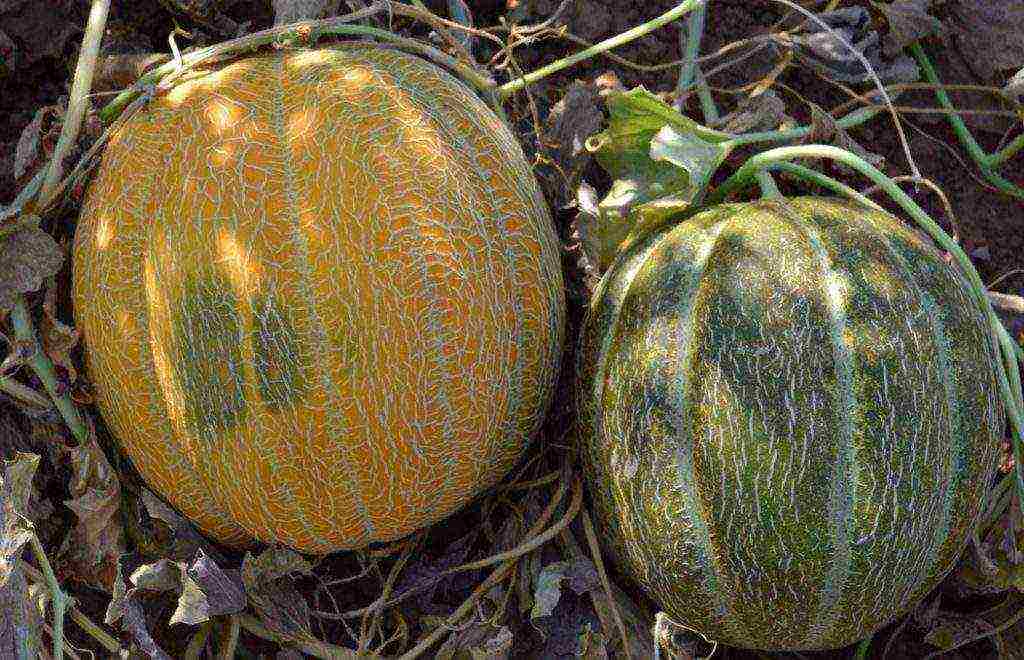
The variety is mid-season, the period from full sprouting to the first harvest is 80-91 days, 10-11 days later than the Zolotistaya standard. The plant is climbing. The leaf is medium-sized, green, slightly dissected.
The fruit is broadly round, dark yellow with an orange tinge, with a net of medium density and medium thickness, slightly segmented, smooth. Fruit weight 2.3-2.8 kg. The pulp is orange, melting, tender, juicy, of excellent taste, with a strong aroma. The seed nest is medium in size, the placenta is wall-mounted, dry, closed. Seeds are medium in size, creamy yellow.
Yield marketable fruits 89-145 c / ha, 43-49 c / ha higher than the standard. The fruits retain their commercial qualities for 14 days after picking. Flameproof.
In 2013, the Ethiopka melon variety was included in the State Register for the Lower Volga Region for growing on dry land in private household plots.
Originator of the variety: agrofirm Search.
Melon Delano, description and characteristics, photo
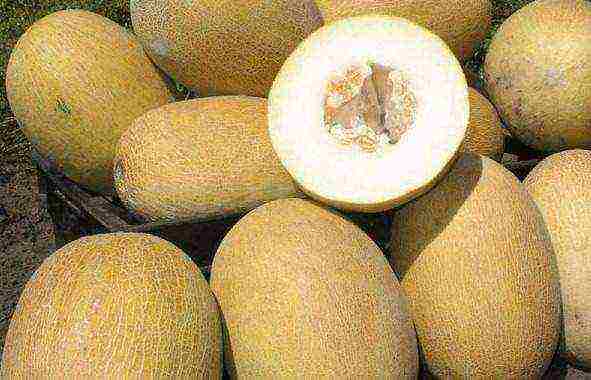
Mid-early, the period from full sprouting to the first harvest of fruits is 63-77 days. The plant is strongly plaited. The leaf is medium-sized, green, slightly dissected.
The fruit is oval, dark yellow, smooth, with a solid mesh of medium thickness. The average weight of the fetus is 1.5-2.3 kg.The pulp is light creamy, thick, tender, melting, juicy, of excellent taste, with a strong melon aroma. The dry matter content is 8.9-10.6%, the total sugar content is 5.7-8.8%. The seed nest is medium in size. Seeds are medium in size, narrow oval, pointed, light yellow. These melons are stable and transportable.
Yield marketable fruits on dry land 88-302 c / ha, 14-104 c / ha higher than Otrada and Tamanskaya standards.
The hybrid tolerates temperature extremes and is resistant to fusarium.
The Delano melon variety was included in the State Register for the North Caucasus region in 2009.
Originator: NUNHEMS (Holland)
Melon Amal, description, photo
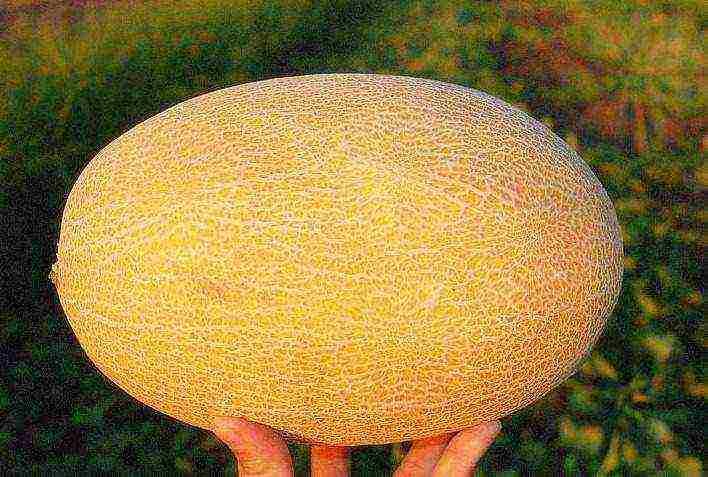
Mid-season melon hybrid. The plant is climbing. The leaf is medium-sized, green, strongly dissected.
The fruit is elliptical, ocher in color, with a pattern in the form of dots, smooth, with a fine continuous mesh of a linear structure. The average weight of the fetus is 1.4-2.6 kg. The pulp is dark creamy, thin, melting, tender, juicy, excellent taste, with a strong aroma. The dry matter content is 8.4-11.0%, the total sugar content is 5.5-7.6%. The seed nest is small, the placenta is central, dry, closed. Seeds are medium in size, narrow oval, blunt-pointed, creamy yellow.
Yield marketable fruits on dry land are 93-140 c / ha, for Otrada and Tamanskaya standards - 108 and 88 c / ha.
Dignity: excellent transportability, resistance to fusarium.
Melon hybrid Amal F1 in 2009 was included in the State Register for the North Caucasus region.
Originator: CLAUSE (France).
Melon Lada
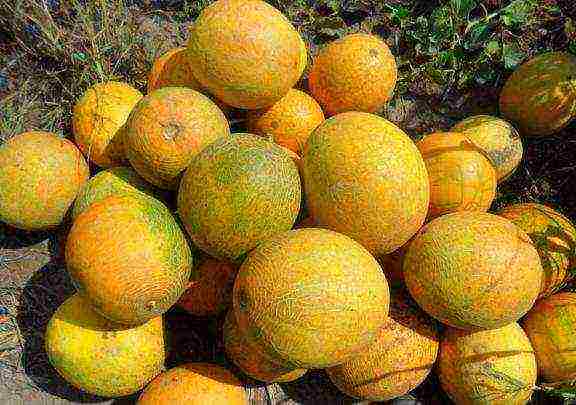
A mid-season melon variety, the period from full germination to removable ripeness (first harvest of fruits) is 74-96 days. The plant is climbing, the main lash is of medium length. The leaf is medium-sized, green, slightly dissected.
The fruit is round, yellow at the stage of maturity, without a pattern, smooth, with a solid mesh, weighing 1.5-2.0 kg, resistant to cracking. The pulp is of medium thickness, light creamy, crispy, tender, juicy, weak aroma. The taste is good and excellent. The dry matter content is 10.5%, the total sugar content is 8.4%. The seed nest is medium in size, cream. Seeds are oval, ivory. The mass of 1000 seeds is 39.6 g. The seed yield is 1.5%.
Marketable yield fruits under irrigation 211-218 c / ha, at the level of the Yuzhanka standard.
Advantages of the variety: resistance to powdery mildew, tolerance to downy mildew and aphids.
Melon variety Lada in 2005 was included in the State Register for the Lower Volga region.
Originator of the variety: All-Russian Scientific Research Institute of Irrigated Vegetable and Melon Growing.
Melon Fairy Tale
An early ripening variety, the period from full germination to removable ripeness (first harvest of fruits) 60-62 days. Maturation is amicable. The plant is climbing. The leaf is medium-sized, green, slightly dissected.
The fruit is elliptical, yellow at the stage of maturity, without a pattern, slightly segmented, with a sparse mesh, weighing 1.6-1.8 kg (up to 2.3 kg). The pulp is light creamy, 2.5-3.0 cm thick, crispy, medium juiciness, sweet, with a weak aroma, good taste. Dry matter content 11.0-12.0%, total sugar 9.0-10.0%. The seed nest is medium in size, consisting of three dry, closed placentas. Seeds are narrow oval, ivory. The mass of 1000 seeds is 41 g. The seed yield is 1.0%.
Melon yield Fairy tale: 2.1-2.3 kg / m2, for the first two collections - 0.3-0.4 kg / m2.
This melon is recommended for local consumption as it is not suitable for long distance transportation. The fruits retain their commercial qualities for 5-10 days after picking.
Dignity: resistance to powdery mildew, tolerance to downy mildew, early maturity, amicability of ripening.
Melon variety Skazka in 2001 was included in the State Register of the Russian Federation for garden plots, home gardens and small farms for growing in open ground and under film shelters.
Originator of the variety: LLC Semko-Junior.
Altai melon
A good, time-tested early-ripening melon variety. The period from full germination to the first harvest of fruits is 65-75 days. Medium-sized plant, medium-growing.The leaf is pentagonal, weakly and strongly dissected, small. The petiole is short, oblique.
The fruit is oval and short-oval, of medium size, weighing 0.8-1.6 kg. The surface of the fruit is smooth or slightly segmented. In a ripe melon, it is lemon or orange-yellow in color, without a pattern, in an unripe melon it is green or dark green. The mesh varies from partial to complete, medium-mesh, delicate. The bark is soft. The pulp is light orange or white, thin, grainy, aromatic. The seed nest is large, the placenta is semi-liquid or liquid, filling less than half of the seed nest. The palatability of the fruit is satisfactory.
Flaws: low transportability and keeping quality of fruits.
Marketable yield: 25.0 t / ha (with proper cultivation techniques).
The Altai melon variety was approved for use in the Ural, West Siberian and East Siberian regions in 1955.
Originator of the variety: WESTERN SIBERIAN VEGETABLE EXPERIMENTAL STATION VNIIO.
Melon Caramel
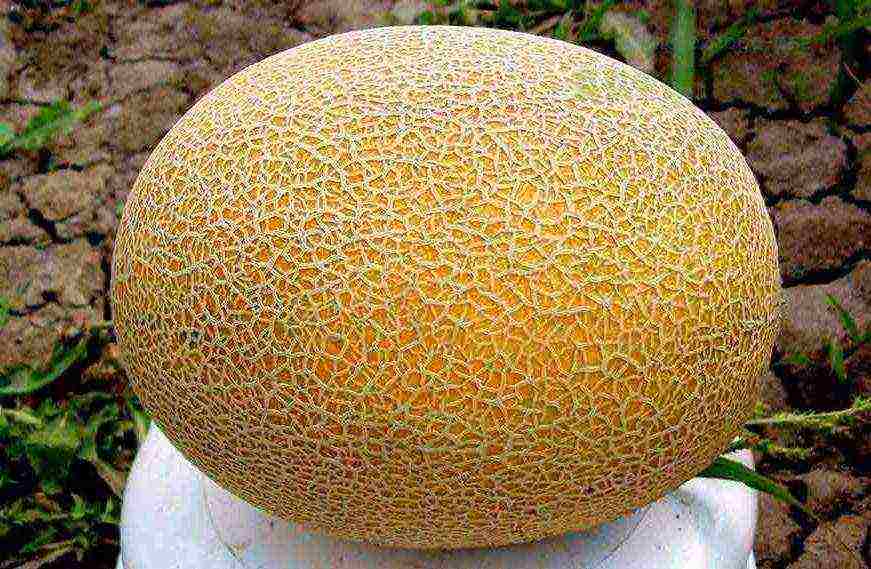
Medium early hybrid of a melon, the period from full germination to the first harvest of fruits 62-66 days. The plant is strongly plaited. The leaf is medium-sized, green, slightly dissected.
The fruit is oval, dark yellow at the stage of maturity, smooth, with a continuous thick net. Fruit weight 1.2-1.9 kg. The pulp is light creamy, thick, tender, melting, juicy, of excellent taste with a strong aroma. The dry matter content is 8.5-9.8%, the total sugar content is 5.4-7.6%. The seed nest is small, the placenta is central, dry, closed. Seeds are medium in size, oval, blunt-pointed, creamy yellow.
Yield marketable fruits on dry land 94-156 c / ha, at the Otrada standard - 104-128 c / ha. The maximum yield is 260 c / ha, 172 c / ha higher than the Tamanskaya standard (Krasnodar Territory).
Hybrid advantages: transportable, tolerates waterlogged soil well, resistant to fusarium.
Melon hybrid Caramel F1 in 2009 was included in the State Register of the Russian Federation for the North Caucasus region.
Originator: CLAUSE (France).
Melon Aikido

Mid-early - mid-season melon hybrid. The plant is climbing. Medium-sized leaf, dark green, dissected.
The fruit is round, yellow at the stage of maturity, segmented, with a net of medium density, weighing 1.4-2.1 kg. The pulp is light green, thick, melting, tender, juicy. The taste is good and excellent. Melon aroma. Seed nest of medium size, placenta - 3, their position is central. The seeds are creamy yellow, medium in size.
Yield marketable fruits on dry land 92-119 c / ha, at the level of the Otrada standard, for the first two harvests - 34-56 c / ha, at the standard level.
The hybrid is resistant to fusarium.
Melon Aikido F1 in 2006 was included in the State Register for the North Caucasus region for cultivation in private household plots.
Originator: SAKATA.
Melon Raymond
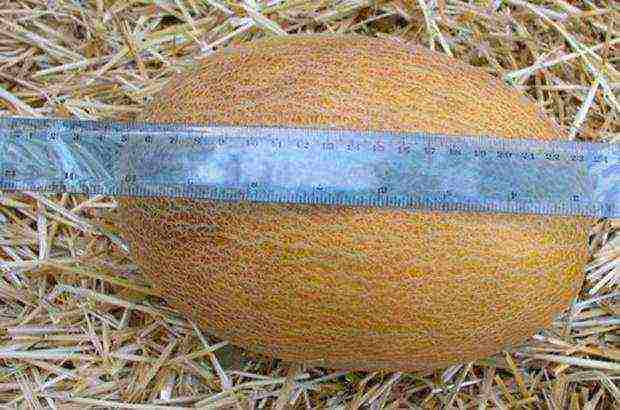
Medium early hybrid, the period from full germination to the first harvest of fruits 65-75 days, 2-5 days later than the Golden standard. The plant is climbing. Medium to large leaf, light green to green, slightly dissected to dissected.
The fruit is elliptical, yellow with an ocher tinge, smooth, slightly wrinkled, with a dense, medium-thick mesh. Fruit weight 2.0-3.6 kg. The pulp is creamy, thin, crispy, tender, medium-bodied, good taste. The dry matter content is 9.2-9.3%, the total sugar content is 6.6-6.9%. The seed nest is medium in size, the placenta is central, semi-liquid, open. Seeds are blunt-pointed, creamy yellow.
Yield marketable fruits in the North Caucasus region when grown on dry land 108-284 c / ha, 7-213 c / ha higher than the standard, in the Lower Volga region when grown on dry land -112-128 c / ha, standard - 56-96 c / ha / ha, with irrigation - 214-346 c / ha, for the standard - 258-359 c / ha.
The hybrid is transportable. The fruits retain their commercial qualities for 30-40 days after picking.
Melon Raymond F1 in 2011 it was included in the State Register of the Russian Federation for the North Caucasus and Lower Volga regions.
Originator: HAZERA (Israel).
Melon Dune
An early ripening variety, the period from full sprouting to the first harvest of fruits is 58-75 days. The plant is climbing.The leaf is medium-sized, green, slightly dissected.
The fruit is oval, yellow at maturity, solid mesh, medium density. The average weight of the fetus is 1.4-1.7 kg. The pulp is light creamy, thick, grainy, dense, tender, juicy, of excellent taste. Melon aroma. Seeds are oval, blunt-pointed, medium-sized, ivory-colored. The mass of 1000 seeds is 41 g. The seed yield is 0.7%.
Yield marketable fruits on dry land 92-150 c / ha, 5-28 c / ha higher than the Autumn and Zolotistaya standards, with irrigation - 374-398 c / ha, at the level of 108 c / ha higher than the Zolotistaya standard.
The variety has good transportability.
Melon variety Dune in 2008 was included in the State Register for the Lower Volga region.
Originator of the variety: Bykovskaya Melon Breeding Experimental Station VNIIO.
Melon Cossack
A mid-season variety, the period from full sprouting to the first harvest of fruits is 70-95 days. The plant is long-leaved, medium-sized, with a thin stem. The leaf is reniform, strongly globular, of medium size.
The fruit is oval, medium-sized, weighing 1.2-1.8 kg. The surface of the fruit is smooth or slightly segmented, at the stage of maturity is bright yellow, without a pattern, sometimes mesh elements are found. The bark is hard, medium-strength. The pulp is white, of medium thickness, fibrous, slightly crunchy, dense, juicy, sweet. The severity is average. The seed nest is medium in size. The palatability of the fruit is good.
Yield: 17.7-28.7 t / ha.
The variety is moderately affected by powdery mildew and anthracnose.
Variety value: good transportability of fruits. Approved for use in the North Caucasian and Lower Volga regions in 1964.
Originator of the variety: JSC ‘ROSTOVSORTSEMOVOSCH’
Melon Cinderella
An early ripening variety, the period from full germination to removable ripeness (first harvest of fruits) 60-72 days. The plant is climbing. The leaf is medium-sized, green, slightly dissected.
The fruit is oval, yellow, without a pattern, smooth, with a solid mesh, weighing 1.1-2.2 kg. The pulp is light creamy, 3.0-3.5 cm thick, crispy, juicy, tender, of good taste. Dry matter content 7.0-11.4%, total sugar 5.4-9.3%. The seed nest is small, consisting of three central, dry, open placentas. Seeds are narrow oval, ivory. The mass of 1000 seeds is 46 g. The seed yield is 0.7%.
Marketable yield fruits 134 c / ha, for the first two harvests - 96 c / ha. The output of marketable products is 85%.
Melon Cinderella is recommended for local consumption. The fruits retain their commercial qualities for 15-20 days after picking.
The variety is resistant to low and high air temperatures.
In 2005, the Cinderella melon variety was included in the State Register of the Russian Federation for garden plots, home gardens and small farms.
Originator: BRANCH KUBAN OS VIR (KRASNODAR REGION).
Melon Tamanskaya
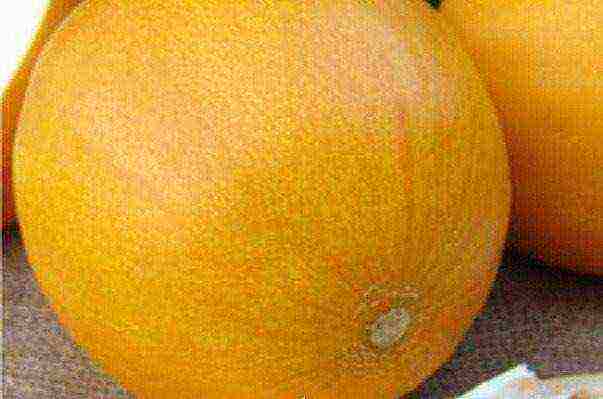
An early ripening variety, the period from full sprouting to removable ripeness (first harvest of fruits) is 53-80 days. The plant is climbing. The main lash is of medium length. The leaf is medium-sized, green, slightly dissected.
The fruit is oval, yellow in color, without a pattern, smooth, with a mesh of medium density. The seed nest is large, the position of the placentas is wall-mounted, the structure is open. The bark is thin, creamy on the cut. The pulp is creamy, of medium thickness, crumbly, grainy, tender, juicy. Fruit weight 0.5-1.3 kg. Good taste. The dry matter content is 8.1-12.5%, the total sugar content is 5.7-11.2%. Seeds are narrow oval, ivory. The mass of 1000 seeds is 28 g.
Yield marketable fruits on dry land 49-169 c / ha, for standards Zolotistaya and Otrada - 55-217 c / ha, for the first two harvests 34-104 c / ha, for standards - 37-78 c / ha.
The variety is transportable.
Melon variety Tamanskaya in 2004 was included in the State Register of the Russian Federation for the North Caucasus region.
Originator of the variety: VNII RISA (Krasnodar).
Melon Temryuchanka
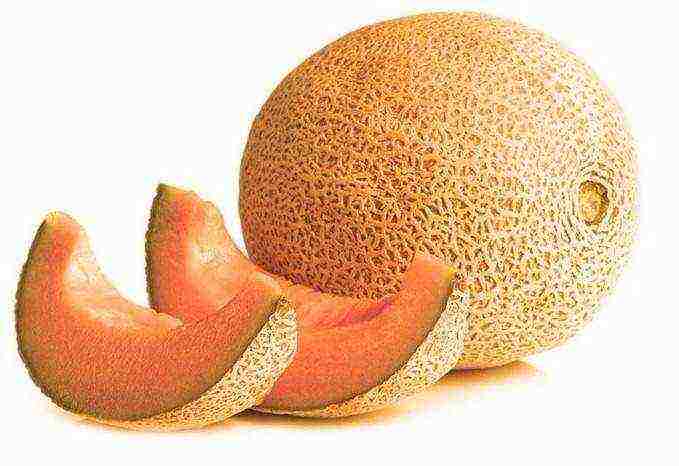
A mid-season variety, the period from full sprouting to the first harvest of fruits is 70-95 days. The plant is climbing. The leaf is medium-sized, green, slightly dissected.
The fruit is round, at the stage of maturity, dark yellow, without a pattern, slightly segmented, strongly wrinkled with a thick continuous mesh. Fruit weight 1.4-2.1 kg. The pulp is light creamy, thick, tender, melting, juicy, very sweet, excellent taste, with a melon aroma. The dry matter content is 8.3-11.1%, the total sugar content is 5.5-8.7%. The seed nest is small. The seeds are large, oval, blunt-pointed, ivory-colored. The mass of 1000 seeds is 35-40 g. The seed yield is 1.1%.
Yield marketable fruits on dry land 108-178 c / ha, 11-27 c / ha higher than the standards of Kazachka 244 and Zolotistaya. The maximum yield is 317 c / ha, 186 c / ha higher than the Zolotistaya standard (Krasnodar Territory).
The variety is transportable, resistant to stressful conditions. The fruits retain their commercial qualities for 25-30 days after picking.
The melon variety Temryuchanka in 2008 was included in the State Register of the Russian Federation for the North Caucasus and Ural regions.
Originator of the variety: VNII RISA, Tsybulevsky Nikolay Ivanovich (Krasnodar).
Melon Gold of the Scythians
Medium early hybrid of a melon, the period from full germination to removable ripeness (first harvest of fruits) 70-80 days. The plant is climbing. The leaf is medium in size, light green, slightly dissected, strongly toothed along the edge, slightly wavy.
The fruit is round in shape, when ripe it is yellow, with a thin dense net. The seed nest is medium in size. The position of the placentas is central. The pulp is creamy, 3.5 cm thick, melting, tender, juicy, sweet, aromatic. Fruit weight 1.1-1.3 kg. The taste is excellent. Seeds are narrow oval, ivory. The mass of 1000 seeds is 41 g.
Yield marketable fruits 6 kg / sq.m.
Hybrid value: high yield, excellent taste of fruits, resistance to powdery mildew.
In 2002, the Zlato Scythian F1 hybrid was included in the State Register of the Russian Federation for garden plots, home gardens and small farms for growing under film shelters.
Originator: LLC Selection firm Gavrish.
If you grow any other good melon varieties, please share your opinion in the comments. If possible, attach a photo of them. Your feedback on the varieties of melons will help many of our readers to learn more about them and decide which varieties and hybrids to plant on their site.
Early melon varieties mature within 60-70 days. This is a very short time, thanks to which a chance to grow a tasty, juicy melon appears even among summer residents in northern regions with an unpredictable climate. The best early varieties of melons will be discussed in the article.
Which early melon varieties are best?
The best early varieties of melon are distinguished by an early ripening period, excellent taste and survival rate in different climatic zones.
- "The dream of a lazy person" or "Dream of Sybarite" ripens in only 50-55 days. Fruits are medium, elongated, up to 500 g. The peel is green-striped. The pulp is juicy and sweet, with a honey aroma and flavor. Up to 15 fruits can ripen on one bush per season.
- "Muscat White" - the growing season is 60 days. Fruit weight - 600-2000 g. The pulp is white, juicy, sweet, but if it ripens, it will taste sugary-sweet. It is very resistant to temperature extremes and frost, so it is grown in greenhouses even in the northern regions.

Melon in the greenhouse
- "Caramel" - high-yielding, early ripening (60-66 days) variety of melons. Fruits are oval, yellow-green with a mesh pattern, weighing 1.6-1.9 kg. The pulp is very aromatic and sweet (sugar - 7.6%). Transportable, resistant to fusarium, tolerates high humidity.
- "Delano F1" matures in 65 days, and at least 55 days under good conditions. Frost-resistant variety, can be grown outdoors or in a greenhouse. The fruits are oval, from 2.5 to 5.5 kg, yellow-orange in color. The peel is mesh. Differs in resistance to diseases.
- "Cinderella" has dark yellow, reticulate, medium-sized fruits weighing up to 1.3 kg. Ripens by 62-70 days. The pulp is very sweet, compared to some other varieties - the sugar content is 8.1%. The pulp is white or creamy, aromatic, soft. The skin is thin.Can be stored for up to 2 weeks - transportable. Resistant to diseases and temperature extremes.
- "Early 133" grown outdoors or in a greenhouse. The growing season is 60-70 days. The fruits are round, yellow, with a barely noticeable mesh. The pulp is white, juicy and sweet, crunches. It is appreciated for its transportability and resistance to anthracnose and fusarium.
- Titovka - early variety, ripens in 60-70 days. Fruits weighing up to 2 kg. The peel is yellow with a small mesh. The pulp is fibrous, juicy, sweet. It is often grown commercially due to its high resistance to frost and disease.
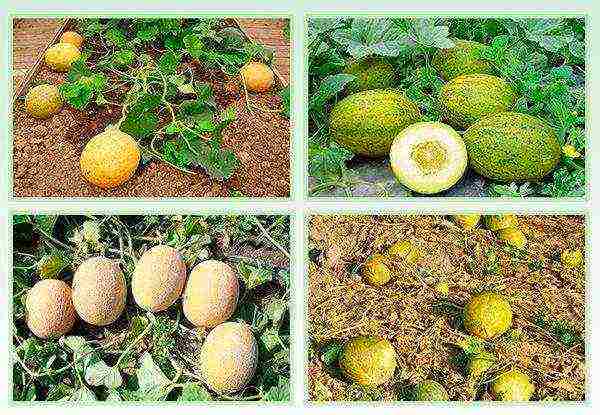
Melon in the garden
- "Amal" - early ripening hybrid variety, ripens in 70 days. Fruits are elongated, yellow with a light mesh on the rind. The pulp is pale, tender and juicy. The variety has many advantages and disadvantages. So, for example, a melon is resistant to fungi, some diseases, pests, tolerates a cold snap without problems, but requires painstaking care: weeding, the right place without drafts, fertilization. Sugar in 100 g is about 7%.
- "Star in the garden" or "Silver Star" - the growing season is 63-68 days. It looks like a big white egg with a green spot. Fruit weight is about 2 kg. The pulp is white with a greenish tinge, has a delicate, piquant taste. But the variety has many disadvantages: thermophilicity, poor tolerance to temperature extremes, humidity. Doesn't like transplants. If it is grown in the middle lane, then only in greenhouses.
The best varieties also include the ultra-early ripening melon "Melba", which can ripen in just 30 days, but at the same time its taste suffers a little (it is not very sweet). This also includes: "Dune", "Roksolana F1", "Dakar", Kalmychka ".
What are the sweetest early melons?
Early melon varieties are very rarely sweet, at least not as honey-sweet as late or mid-season varieties. That is why they are rarely planted in plots. However, thanks to selection, many sweet varieties of early ripening have recently appeared. Here are three of the most popular and available ones for sale.
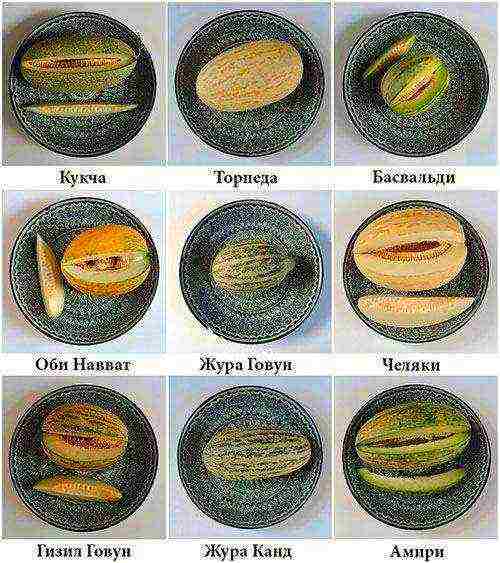
Melon varieties Torpedo
- "Portento F1 " ripens in 65-70 days from the day of planting seedlings. This melon has a record 15% glucose per 100 g of early ripening melon! This is an Italian hybrid. The fruit is light with a spider web pattern and green stripes weighing up to 2.5 kg. The pulp is yellow-orange, juicy, aromatic, and of course sweet.
- Anamax F1 or pineapple melon is a hybrid created by American breeders. This variety is incredibly sweet considering that it ripens 65 to 70 days when planted with seedlings. The percentage of sugar in 100 g is 12-13%. The average fruit weight is 3 kg.
- "Altayskaya" melon has a light orange, sweet flesh. Fruits are oval, yellow-orange, with a net, reach 0.8-1.6 kg, ready to eat on day 63-70. Of the advantages, resistance to temperature extremes, sharp frosts, and pests is noted. But there is also a significant drawback - even with proper care, the plant may not bear fruit.
How to choose and where to buy seeds?
In order to get a good harvest, you need to take high-quality seed for planting.
- Early melon varieties are selected according to the climatic conditions of the region. For the middle and northern regions, these should be frost-resistant crops, which, ideally, can be grown in greenhouse conditions. If you take a thermophilic culture, it will either not yield a harvest, or it will be very bad.
- The variety should be indicated on the package with seeds, and if it is a hybrid, then there should be a note to that effect. Ideally, the manufacturer's address and complete information about the variety are written on the package: when to seedlings, plant, harvest, and so on.

How to choose the right melon
- Seeds are not harvested from hybrid varieties, since they simply do not germinate; for these purposes, a simple varietal culture is taken.
- It is recommended to buy seeds in good stores, and not in the market without the name of the variety and the rules for planting it.This will save time and effort in searching for information, and will also bring more benefits, because the seeds in the markets are usually defective.
- Buying a varietal melon or hybrid is a matter of personal taste. Early hybrids are very sweet, and varietal seeds can be harvested for growing in subsequent years. But if you know a place where good hybrid seeds are sold, then why collect them from the grown fruits?
It is difficult to find a person who would be indifferent to the aromatic and juicy melon. But for a long time, only residents of the south could plant it on their site and fully enjoy the amazing taste of the fruit recently plucked from the bush. The situation has changed dramatically in recent decades. Breeders have created a large number of new varieties and hybrids of this culture, which tolerate well the difficult climatic conditions of many regions of Russia, including the middle lane and even Siberia.
Description and characteristics of common melon varieties
Melon (Cucumis melo) is a herbaceous plant of the genus Cucumber of the pumpkin family, which is native to Central and Asia Minor. Over the thousands of years of its cultivation, many subspecies have appeared, often very different from each other. Among them:
- Asian. Large-fruited subspecies of melon grown on melons of Central Asia. It is widely known for its exceptional taste. Unfortunately, due to the exactingness of climatic conditions, this subspecies is rarely found in other regions.
- Silver or snake melon (Armenian cucumber). It has long, narrow fruits of a light green color, which in an unripe state taste like cucumbers, and after full ripening acquire a melon aroma. Cultivated in Iran, Afghanistan, Tajikistan, Uzbekistan and on the island of Crete.
- Vietnamese or Korean melon is a liana with a long climbing stem and striped fruits weighing no more than 150 grams, which have a sweet taste and a strong aroma. In recent years, this subspecies of melon has begun to gain popularity among Russian gardeners, who appreciated its ability to grow and bear fruit in a cool and short summer.
- Kasaba. A subspecies of melon widespread in many countries of the world with sweet and juicy fruits that do not have a pronounced aroma.
- Cantaloupe. A subspecies of melon, the fruits of which are small in size and bright orange sweet pulp. Often found in Western Europe and America. Recently, cantaloupes have been grown in our country as well.
- Eastern European (Adana). In Russia and Ukraine, it is this type of melon with small rounded fruits that is most often found. Their bark is usually yellow or cream colored, and the light flesh has a sweet, slightly starchy taste and a pronounced melon aroma.
Photo gallery: main varieties of melon
To date, several hundred varieties and hybrids of melons have been bred. When creating many of them, breeders used different subspecies, which made it possible to obtain plants with increased resistance to adverse conditions and excellent taste. Most often, the varieties of this culture are classified according to two characteristics:
- growing method (open or closed ground);
- ripening period (early ripening, mid-ripening or late).
For open ground
Melon is a rather capricious plant. When grown outdoors, it can suffer not only from a lack of heat, but also from extreme heat and a lack or excess of moisture. To obtain a good harvest in such conditions, it is necessary to choose varieties that are characterized by increased resistance to the vagaries of nature. For example:
- Credo;
- Ethiopian;
- Golden;
- Amal;
- Collective farmer 749/753;
- Kazachka 244;
- Aikido;
- Lada.
Recently, the Chengzhou variety has appeared in the stores of our country, which is also recommended for planting in open ground. But it has little to do with melon. Chenzhou is a winter melon or waxy gourd (Benincasa hispida) of the Benincasa genus of the Gourd family.It is very common in Southeast Asia, where salads, hot dishes and candied fruits are prepared from its large (up to 15 kg) fruits. Winter melon and its Chengzhou variety are highly prized for their exceptional keeping quality. The fruits of this culture remain fresh for 1-2 years after harvest.
Ethiopian
A mid-season variety that tolerates extreme heat and lack of moisture well. The period from germination to ripening of the first wave of melons takes no more than 90 days.
Ethiopian fruits are spherical, slightly segmented, with a dark yellow crust covered with a mesh pattern. The pulp is orange, with a pleasant taste and a strong melon aroma.
The average weight of melons ranges from 2 to 3 kg. With industrial cultivation, about 140 centners of fruits are harvested from one hectare, which retain their taste for 2 weeks.
Video: Ethiopian melon tasting
Amal
Mid-early hybrid of French selection with large elliptical fruits. Possesses increased resistance to fusarium.
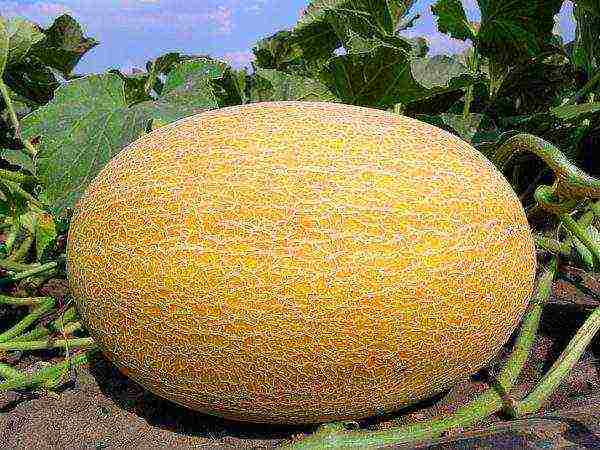
The weight of Amala fruits often reaches 2.5-3 kg
The bark of ripe melons is yellow-brown, with a fine-meshed light mesh. The pulp is creamy, tender with excellent taste and strong aroma. It contains about 10% dry matter and from 5.5 to 7.6% sugars. Small seed nest.
The average yield of the Amal hybrid is from 93 to 140 kg / ha. Thanks to their dense and resilient bark, melons are well tolerated during storage and transportation.
Melon Amal F1 is very juicy, noticeably sweet, and hands stick together from it, which means there is sugar
Kazachka 244
One of the oldest varieties of melons cultivated in Russia. The Kazachka was bred by the specialists of the Biryuchekutsk Vegetable Breeding Experimental Station (Novocherkassk) and entered into the State Register back in 1964.
Oval, slightly segmented fruits of this variety ripen 70–95 days after germination. Their weight can vary from 1 to 1.8 kg. The crust is hard, bright yellow, without a pronounced pattern. The pulp is white, juicy, slightly fibrous and crunchy. The taste is sweet.
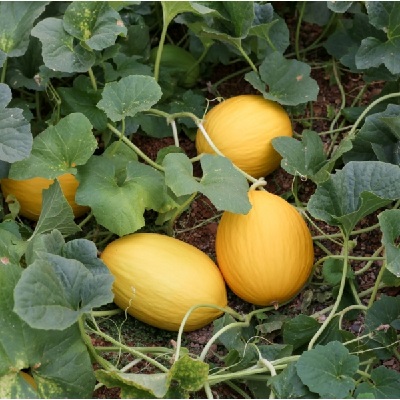
One Kazachki plant can bear two or three fruits
Despite its rather advanced age, Kazachka remains popular with Russian melon growers. Among the advantages of this, they note such qualities as:
- high yield (from 17 to 28 tons per hectare);
- excellent transportability and keeping quality of fruits;
- good taste;
- medium resistance to powdery mildew and anthracnose.
Lada
A mid-season variety, bred by the Astrakhan Institute of Irrigated Agriculture. In southern Russia, it is often used for industrial cultivation.

The average yield of Lada is 211-218 c / ha
Lada fruits are round, weighing up to 1.5–2 kg. The peel is yellow, with a continuous mesh. The pulp is light, juicy, slightly crispy. The taste is sweet with a faint aroma. The sugar content exceeds 8%.
The Lada variety is immune to powdery mildew and rarely suffers from downy mildew and melon aphids. In addition, its fruits are practically not subject to cracking, which is especially important for areas with frequent and heavy rainfall.
Melon grade Lada 2010 - weight 3.5 kg. I just grew up in the OG without shelter. She left one on the bush - she was afraid she would not have time to ripen. The aroma is not very bad and rather sweet, only, most likely, it could be better, because it continued to be watered until it was removed. This year I decided to plant it again.
For greenhouses and film shelters
When growing melons in closed ground, such qualities of varieties and hybrids as compactness and high yields come to the fore. The combination of these factors allows you to get the maximum number of fruits from a small area. The resistance of the culture to fungal diseases, which can quickly spread in the confined space of greenhouses and greenhouses, is also important.
The following varieties of melons feel good indoors:
- Princess Svetlana;
- Augmented;
- Karotel;
- Gold of the Scythians;
- Moon;
- Iroquois;
- Blondie.
Augen
A mid-early hybrid of a melon that came to our country from Israel. Its fruits ripen 80–90 days after germination.
Ojen is characterized by short, compact lashes, which makes it very convenient to grow on a trellis. The fruits are round, medium-segmented. When ripe, the crust acquires a yellow-green color and is covered with a sparse net. The pulp is light green, tender. The taste is sweet, with a pronounced melon aroma.
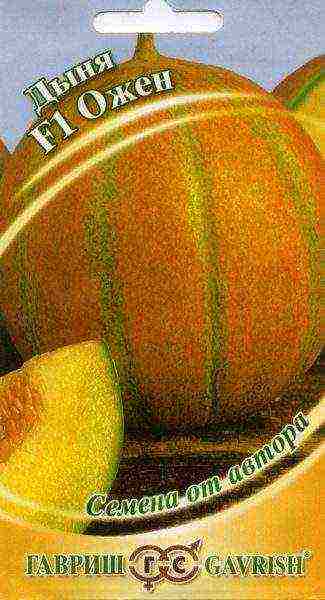
In Russia, the organizer of the Ogen hybrid is the breeding company "Gavrish"
The ripe melons of this hybrid weigh about 1 kg. The average yield is 4–5 kg per sq. m.
September 15 plucked Augen (second wave of fruiting).
It's a pity, I didn't have time to turn yellow, it started to deteriorate, I had to rip it off. But OZHEN turned out to be unripe and very sweet.
In terms of sweetness, this is the sweetest melon I have grown. But as practice has shown, it is still prone to rotting of the stem and fruit in damp cold weather (of course, to a lesser extent than Uzbek melons).
In the open field, most likely nothing will work, but for a greenhouse it is a very good variety.
Gold of the Scythians
Mid-early hybrid. Its round, yellow, with a dense netting, fruits weighing no more than 1.5 kg, are ready for harvesting 70–80 days after the beginning of the growing season. The pulp is creamy, tender, very juicy and sweet. When ripe, it acquires a strong melon aroma.
The Scythian Zlato hybrid is tolerant of powdery mildew and has a high yield. When grown under a film cover, it often exceeds 6 kg per sq. m.
Video: a hybrid of the Scythians Zlato ripens even in the Baltics
Blondie
The Blondie hybrid is a bright representative of cantaloupe melons, which have recently appeared in our country. Its dark orange flesh has a good sweet taste without a pronounced aroma.
Blondie's fruits are oval, segmented. After ripening, their rather thin skin becomes yellow-green in color. Average yield is about 5 kg per sq. meter of landings.
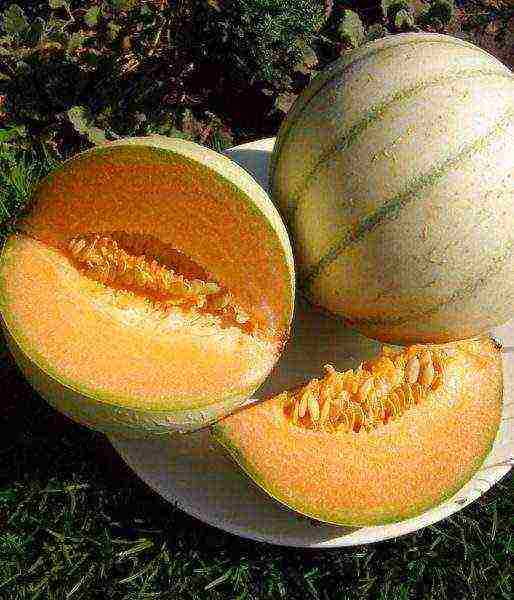
The weight of Blondie fruits rarely exceeds 1 kg
The hybrid is extremely rarely affected by such common fungal diseases as:
- powdery mildew;
- peronosporosis;
- fusarium.
But Blondie also has disadvantages. Its fruits overripe quickly and acquire an unpleasant taste and smell. In order to avoid this, experienced melon growers remove melons from the bush immediately after the appearance of a beige shade in the color of the bark.
There is a sort of "blondie". They are small like apples, but fruitful (a lot). Outside, green-white, striped, inside - bright red. Sweet, but do not have a specific melon smell. Some don't like it. And I love them.
Early ripening varieties
Early ripening varieties and hybrids of melons are especially popular with melon growers in our country. Their fruits take no more than 75 days to ripen, which allows them to be harvested even in regions with short summers. These varieties include:
- Octavia;
- Sprint;
- Cappuccino;
- Miron;
- Cinderella;
- Altai;
- Titovka;
- The passport.
Cappuccino
Dessert melon with a very high sugar content in the fruit. Seed producers claim that under favorable growing conditions, this figure can reach 17%.
Ripening 70–75 days after germination, Cappuccino fruits have a rounded shape. The rind is thin, light yellow or cream in color. The pulp is almost white, juicy and very sweet. Fruit weight can vary from 500 grams to 1 kg.
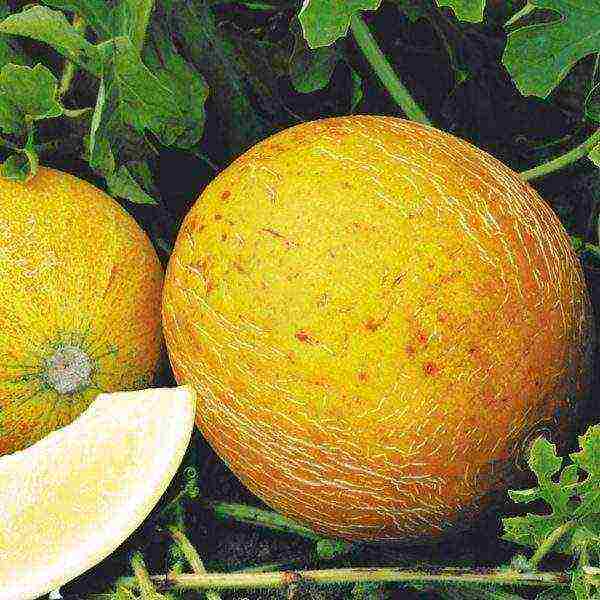
Cappuccino melons are not large in size
What I want to say about this variety is beautiful small melons weighing up to one kilogram, with a creamy shade of fruit bark, sweet and tender pulp. Even unripe fruits smell very fragrant when cut. Last year we tried two things, this year we expect more, there are still seeds left.
Myron
Myron is one of the largest-fruited hybrids of early ripening melons. The weight of its fruits often exceeds 2.5 kg. Despite such a large size, they ripen within 55–77 days after germination.
Melons of the Myron hybrid are egg-shaped. The crust is dark yellow, with a grayish tinge and a medium density net. The pulp is white, tender.It contains about 9% dry matter and 5.3-6.8% sugars. The fruits of this hybrid are delicious and aromatic.

Melons of the Myron hybrid are distinguished not only by their large size, but also by their excellent taste.
Depending on the growing conditions, the yield of Myron ranges from 135 to 478 centners per hectare. The harvested fruits retain their freshness well for 10 days after harvest.
They ate myron. Weight 1680g For a week in the warmth, together with the apple, it did not turn yellow, only yellow stains. Very tasty, sweet and medium-juicy melon, the pulp is not painfully thick with green. I will definitely plant in the trail. year. It was a very powerful, strong plant that survived all the cataclysms in the form of a flood in July. There is one more Mironikha left, but she is only a month old and will probably be completely immature.
Altai
A high-yielding variety of the selection of the West Siberian Vegetable Experimental Station, bred back in 1937. About 25 tons of fruits are harvested from one hectare of Altai melon plantings, each of which weighs 800 grams to 1.5 kg.
Melons of this variety are oval, with a soft yellow crust. The pulp is white, sometimes with an orange tinge, grainy and very aromatic. The sugar content is low.
Altai fruits reach technical ripeness 65–75 days after seed germination. Due to their soft crust, they do not store well and do not tolerate transportation.
Video: personal experience growing melon varieties Altai
Melon varieties for different regions
When choosing a melon variety for planting, it is necessary to take into account its adaptability to the climate of a particular region. So, varieties that grow well and bear fruit in the south of Russia, in more northern regions, may hurt and not bear a large amount of fruit. The taste of the fruit often suffers from an unsuitable climate. In conditions of a lack of heat, some varieties do not gain enough sugars and, even after ripening, do not acquire the characteristic melon taste.
For the south of Russia
Melons are very fond of the hot and dry climate of the south of our country. Melon growers of this region can afford to choose only the most fruitful and delicious varieties for planting:
- Collective farmer;
- Ethiopian;
- Amal;
- Lada;
- Cossack 244.
Video: collecting melons of the Lada variety in the Astrakhan region
For the middle lane and the Moscow region
Every year more and more gardeners in the middle lane decide to plant melons. In order to get a harvest, they need to choose only early and early ripening varieties that are resistant to a lack of heat. For example:
- Cinderella;
- Gold of the Scythians;
- Princess Svetlana;
- Miron;
- Blondie;
- Iroquois;
- Seryozha's love.
For Siberia
The short Siberian summer makes it possible to grow only early ripening melons, which can easily endure the lack of heat and sudden changes in temperature. The most adapted to the difficult climate of this region are hybrids and varieties bred by breeders of the West Siberian Experimental Station. These include:
- Assol;
- Altai;
- Yoke;
- Moon;
- Lyubushka.
The old Russian variety Kolkhoznitsa is also zoned in Siberia. It is characterized by spherical yellow fruits with white crunchy flesh, which has a sweet taste and strong aroma. They ripen on 75–90 days of vegetation. The collective farmer is resistant to bacteriosis, but often suffers from anthracnose and powdery mildew. The average yield is between 14 and 22 tons per hectare.
Choosing the right variety is the key to successful melon cultivation. Moreover, experienced melon growers advise not to dwell on one of them, but to plant several varieties at once. This will increase the chances of getting a bountiful harvest in regions with unfavorable climatic conditions.
Since childhood, I have been fond of growing various plants and have achieved considerable success in this matter. I would be very happy to share my experience. Rate the article:
(0 votes, average: 0 out of 5)
Sweet, tender, juicy, with aromatic crunchy pulp, the golden beauty is a favorite among summer fruits. This is not just a sweet fruit, but a whole storehouse of nutritious minerals, vitamins A, C, P, ascorbic acid. The fruits of this melon plant are considered one of the paradise fruits. Juicy, large melons can be eaten raw, jams and sauces are prepared from them, slices are used in desserts and as a side dish. It goes well with a good beef steak.
Description of sweet dessert
This culture was known a couple of thousand years ago in Ancient Persia and Egypt. In Russia, it appeared already in the 16th century. Under Tsar Peter, it was grown in special greenhouses.
This delicacy has the following composition:
- water;
- proteins;
- carbohydrates;
- cellulose;
- pectin;
- vitamins A, B1, B2, B3, B9, C, E;
- potassium;
- calcium;
- magnesium;
- sodium;
- phosphorus;
- iron;
- iodine;
- manganese;
- copper;
- fluorine.
Doctors advise eating foods from the fruits of this plant while losing weight. They help remove excess fluid from the body and are even a good remedy for cellulite. They strengthen the immune system and normalize the menstrual cycle.
But for diabetics and people with diseases of the gastrointestinal tract, it is better not to eat this delicacy.
Any sweet tooth is looking forward to summer to finally taste delicious fruits - the first melon harvest. The sunny melon delicacy adored by adults and children has a variety of characteristics. It depends on which variety you choose. It can be an elliptical melon, yellow with white flesh, Snowflake F1, round melon with an orange mesh skin, Dubovka melon, or Melon Sweet miracle. The name of the variety of this melon speaks for itself about its characteristics.
Growing this fruit is not easy: the plant is not resistant to various diseases and pests, and is sensitive to temperature extremes. Cultivation begins with the selection of the right place: cultivation will be successful in a warm, windless area with fertile soil. You can feed the soil in the early stages with organic, potash and phosphate fertilizers. It is better to buy Dutch melon seeds and plant them in peat pots for seedlings, but still a high-quality and lush harvest is guaranteed only if you choose the melon variety that suits the climatic conditions of the landing site.
Much has been written about what melons are. But we decided that it would be better to sort everything out on the shelves and present the best varieties, dividing them into groups according to the ripening period.
Early varieties
The largest number of lovers of the first type. Early types of melons are those with sixty-five days from cotyledon emergence to harvest. Such plants thrive in areas with short and cool summers. They are great for wholesalers. Growing them is inexpensive because of their early maturity.
The early ripe ones include dwarf and ordinary individuals: Titovka melon (the most popular variety among gardeners), Roksolana melon, Ambrosia melon, Ignazio melon, Dina melon, Cinderella, Assol, Altai, Scythian gold, Raymond, Delano, Bijur and others.
The early melon crops include a whole type - the Galia melon. Do not confuse the types and varieties of melons. The type unites varieties of individuals with similar characteristics: super early, bright yellow, like bananas, round, small in size. This is an Indian melon culture, but it is believed that it was developed in Israel. Melon Galia also exists as a variety. The flesh of the melon is greenish-white, crispy.
Raymond loves warm areas in the sun. During planting by seedlings, the fruits become ripe in a month and a half, when sowing seeds in open ground - after 60–65 days. Raymond F1 is famous for its large pumpkins, ideal oblong shape. The skin has a bright yellow net color, ribbed to the touch, dense. The inside of a ripe dessert vegetable is comparatively not very juicy and has a honey flavor. The seed chamber occupies a very small percentage of the area. The plant is short, with a powerful root system.When the weather is suitable for the correct development and the correct agronomic approach, the culture sets 5 fruits each.
Scythian gold has a ripening period of up to eighty days. It demonstrates itself best in greenhouses. The fruits are round, yellow, reticulate, small (1–1.5 kg). Growing begins in seedlings at the beginning of May. They are planted in open ground according to the scheme 70 by 150 cm.
Delano is an early ripening variety with abundant fruiting. Fruits are elliptical, reticulate, weighing up to 6 kg, sunny in color. The pulp is snow-white, without fibers, with a small seed chamber. Has a very strong characteristic aroma. Up to 4 fruits are tied on the plant, while it is recommended to sow 6-8 thousand seeds per hectare.
The fruits are resistant to disease and weather variability. Very presentable and perfectly transportable.
Ignazio F1 is a highly productive hybrid. Many fruits are set on one plant. A massive leaf system shelters the fruits from the sun's rays. The fruits themselves are elliptical, weighing up to 5 kg, have a hard peel. The snow-white inside, fleshy, during storage remains the same as when collected. Stored for several months.
Roksolana F1 is an early ripe hybrid that belongs to the above-described species. Ripens in about sixty-five days. Thanks to the massive leaf system, the fruits do not get sunburn. The flesh is creamy and the rind is light yellow. Requires a well-lit area. Care includes pinching, watering and feeding.
Assol belongs to the Altai species. The fruits are obtained with a weight of 1000 g. The peel is dirty yellow in color with green stripes. The inside is grainy, tender, juicy.
Winter melon (cassaba) is an early plant that has medium-weight spherical fruits. The rind is golden or creamy. A feature of the cassaba melon is its high transportability and increased taste during the winter storage period.
Melon varieties such as Pineapple are also early varieties. Melon Oksana F1 belongs to this type. This is a hybrid insensitive to fusarium wilt and powdery mildew, the cultivation of which will not be difficult. Striped melon is also considered pineapple.
Bizhur - hybrid is a very early, high-yielding plant of the Pineapple cultivar. It matures over seventy days and has a powerful leaf system. Has an oval or oval-elongated shape. Fruit weight varies from 2 to 3 kg. The inside is very juicy and sweet. The fruit tastes like honey, suitable even for baby food.
Melon Goldie is a pineapple-type hybrid known for its high yields, honey flavor and disease resistance. The average weight of a mature plant is 3.5 kg.
The F1 Lychee melon is practically the earliest melon of melons, because its ripening period is about thirty-five days. Why is it so attractive to growers? Because its peel is not yellow, not pink, or even orange, but white, like a chamomile.
Melon Golpri Gold has the following description: on one plant 2-3 fruits are formed, the average weight of which is 3000 g. Golpri Gold F1 has an orange skin and soft creamy flesh. Differs in its heat resistance.
Mid-season varieties
Melon Don Quixote, Primal, Anzer, Cappuccino, Northern Star melon, Anna Max melon, Jumbo, Chogare, Assate, Sunny delicacy melon, Hermius, Luna are considered to be medium early. Their ripening period does not apply to either the early or the average and is seventy days.
Fruits are globular, creamy yellow rind with a wide net. On average, the fruits weigh 1.5 kg. The inside is dense, sugary, pleasant to the taste. 10 thousand seeds are sown per hectare. The hybrid is resistant to stressful conditions, fusarium and other melons and gourds. The fruits are good for transportation and storage.
Jumbo has a ripening period of 90-100 days from the start of sowing. Produces a good harvest when grown in greenhouses. The plant is powerful, climbing.Fruits are elongated, elliptical, weighing up to two kilograms, depending on the observance of the rules of agricultural technology. The skin is reticulate, with distinct segments, creamy yellow with light green color. The inside is orange. The dessert vegetable tastes great, has a fiberless texture, and is resistant to a number of common diseases.
Sowing: at the end of April in peat pots at a temperature of 25-30 degrees Celsius. It is necessary to transplant into a greenhouse when 4 true leaves appear, and into fertile soil.
Care includes such processes as pinching, regular but moderate irrigation, fertilizing with complex fertilizers. The crop is ready to be harvested at the end of summer.
Don Quixote F1 is a mid-season hybrid with oblong fruits of about 5 kg. The skin is green with a distinct mesh. The inside is white and soft, sweet, sugary. The fruits are stored for almost ninety days.
The hybrid is bred in such a way that it is resistant to fusarium, powdery mildew.
Melon Kamar is a plant with rounded-elongated mesh-type fruits and a very small seed chamber. Feature - high resistance to fusarium wilt.
Melon Chudo-Yudo - medium early, has round fruits weighing up to 2.5 kg. The name of the melon does not inspire confidence, but in fact, the fruits are very presentable and sweet.
Mid-season popular varieties: Marquise melon, Sweet Tooth melon, Bereginya, Dzhukar.
Melon Blondie is recognizable for its characteristic stripes on the white skin. It is better to start growing this variety in April. Its fruits are the smallest among all white melons - about 600-700 g.
Ethiopian has a ripening period of eighty days. The plant does not spread widely. The leaves are heart-shaped, and the fruits are round, light yellow, very clearly segmented. The inside is white and dense.
Amal F1 is the most popular mid-season variety. From the moment of emergence to fruiting, an average of seventy-nine days pass. The fruit is very presentable and attractive to consumers. It is light golden, oval and reticulate. The pulp is tender, melts in the mouth, yellow with a pinkish tinge. Perfectly transported for about a month. Excellent candied fruits and marmalades are prepared from this variety.
Melon Creme brulee is a mid-season long-leaved plant. The fruits are oval, smooth, yellow-orange, like cauliflower.
Melon Unusual F1 - really from the "exotic" section, because it looks more like a pumpkin. Usually it is grown under a film (less often in the open field). The pulp is oily, very juicy and fragrant.
Late varieties
Late melon is the most popular among gardeners. Obviously, everyone has heard of such varieties as Princess Maria melon, Powdered sugar melon, Emerald melon, Torpedo, Walking.
Princess Maria is known among gardeners for good germination, balanced taste and unusual color. This is a late hybrid. Fruits are spherical, gray-green, with a whitish mesh. They grow to a mass of 1.3–1.5 kg. The pulp is rich orange, juicy, sugar, with a nutmeg aroma. The peculiarity of the hybrid is its resistance to bacterial and viral diseases.
It is cold-resistant, has a wonderful aroma, and is suitable for storage. In areas with a cold climate, this hybrid is grown under a film in a greenhouse. Leaving necessarily includes pinching the shoots. Watering is stopped 10-15 days before ripening. This variety can be eaten without heat treatment, and sweets can also be prepared.
Melon Zimovka is a late variety of the Altai type. The flesh of the melon seems to be emerald in color, of medium thickness. The weight of the fetus reaches 2.5 kg. It is easily transported and stays sweet for a long time. You can harvest on the ninetieth day.
Torpedo - this variety ripens for more than 110 days. This plant is excellent for long-term storage and transportation. Until early spring, fruits weighing 5–8 kg do not lose their taste. They are elongated in shape, yellowish, covered with a fine mesh. The inside is soft, juicy, snow-white.A pleasant aroma comes out during cutting.
Gulyabi is a Central Asian sweet melon. Ripens in 133 days and yields 15 kg per square meter. Fruits are ovoid, weighing up to 8000 g. The surface is divided into small, barely visible segments. The fruit is dark yellow in color, with a hard skin.
The late types of melons include Piel de Sapo. This type combines oval, crack-resistant, ribbed fruits weighing up to 2.2 kg. The flesh is snow-white, and the rind is hard and dark green. This type includes the varieties Ricura and Mabel.
Whatever the variety, it is affected by the same diseases and pests. These are powdery mildew, fusarium wilting, peronosporosis, anthracnose, root rot. Unwanted guests are melon aphids, wireworms and spider mites.
You need to be prepared for all these diseases in advance so that the money spent on quality seeds is not wasted.
Each of them determines the best varieties of melon according to their own criteria. Someone needs walnut-sized fruits, someone likes exotic, unusual melons like Kiwano. Someone is worried about growing and trying to find the best seeds.
It doesn't matter if it is bush melon, Turkish orange melon, banana melon or kiwi melon. The main thing is to follow all the most important stages of growing and care. Then the sweet beauty will delight with aroma and summer taste on the family table and bring a huge income.
Video "Planting melons in open ground and greenhouse"
In this video, you will learn how to plant plants in open ground and in a greenhouse.


